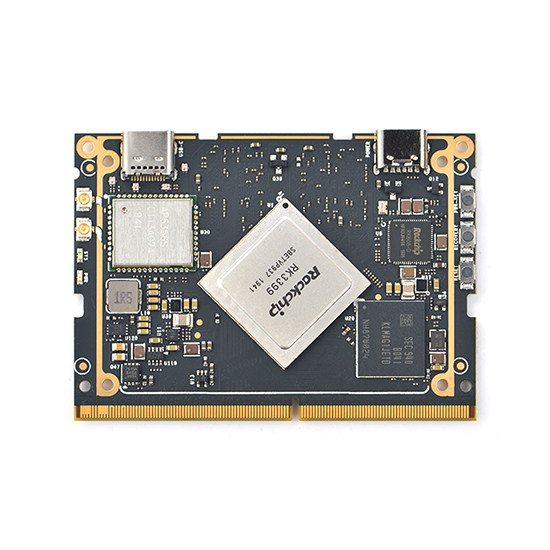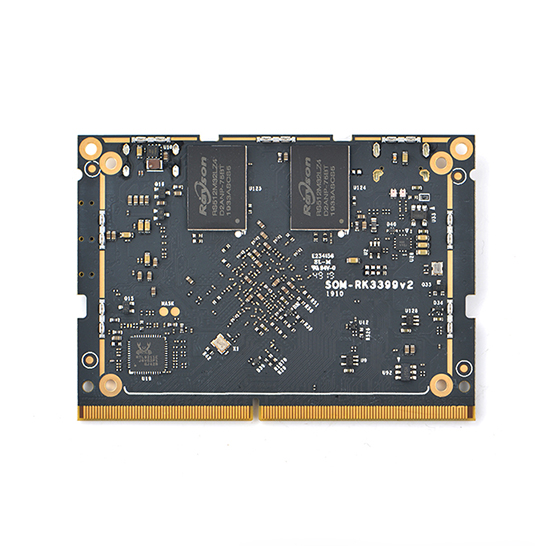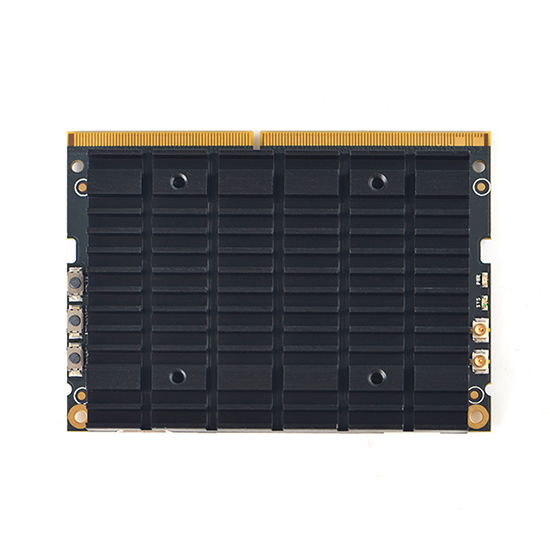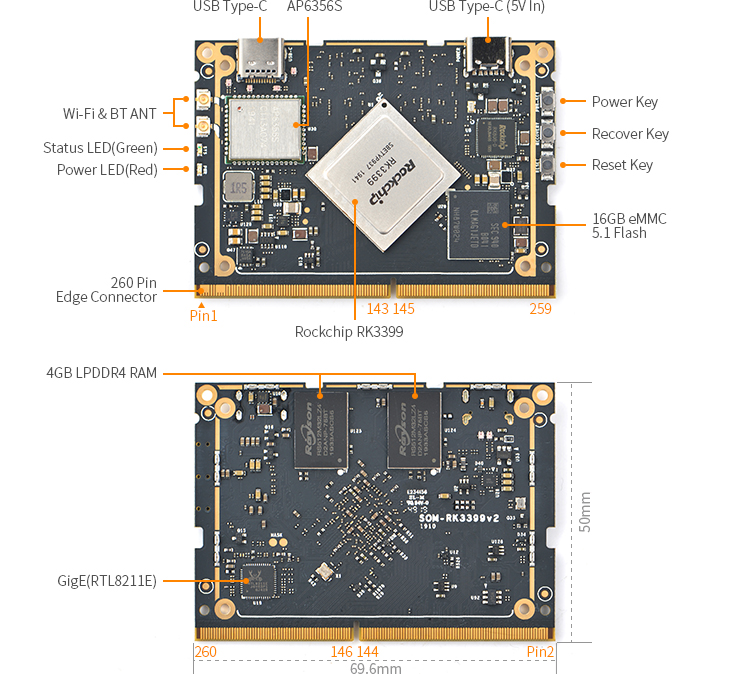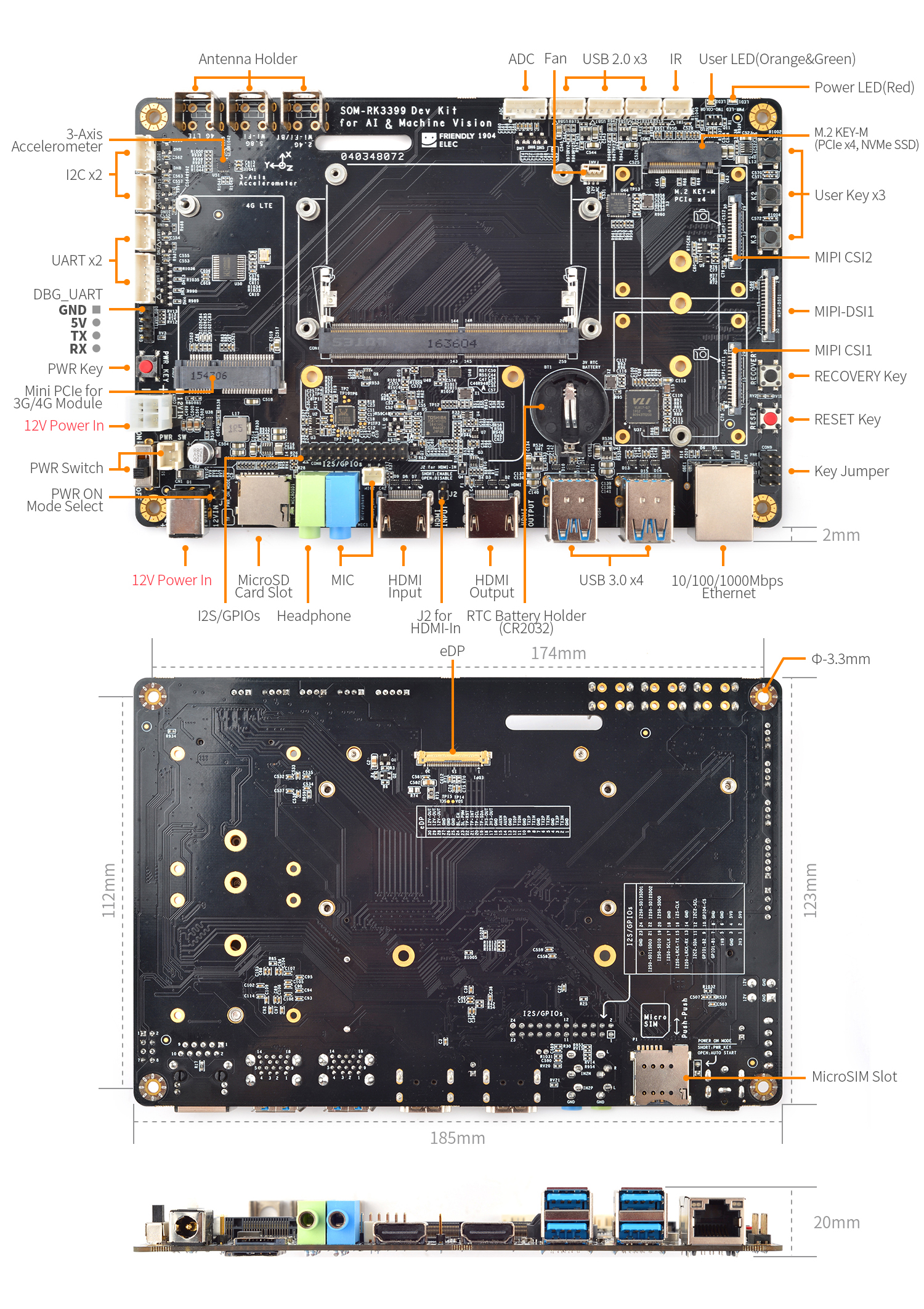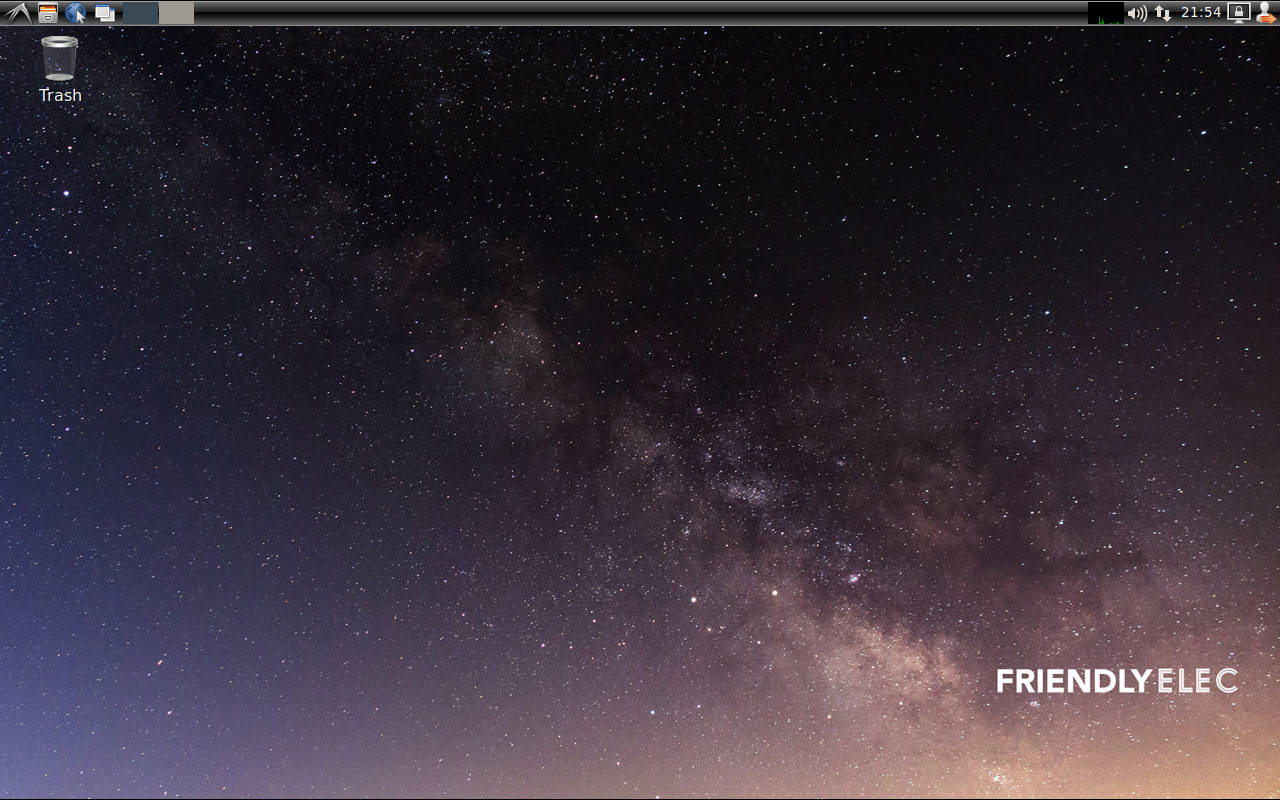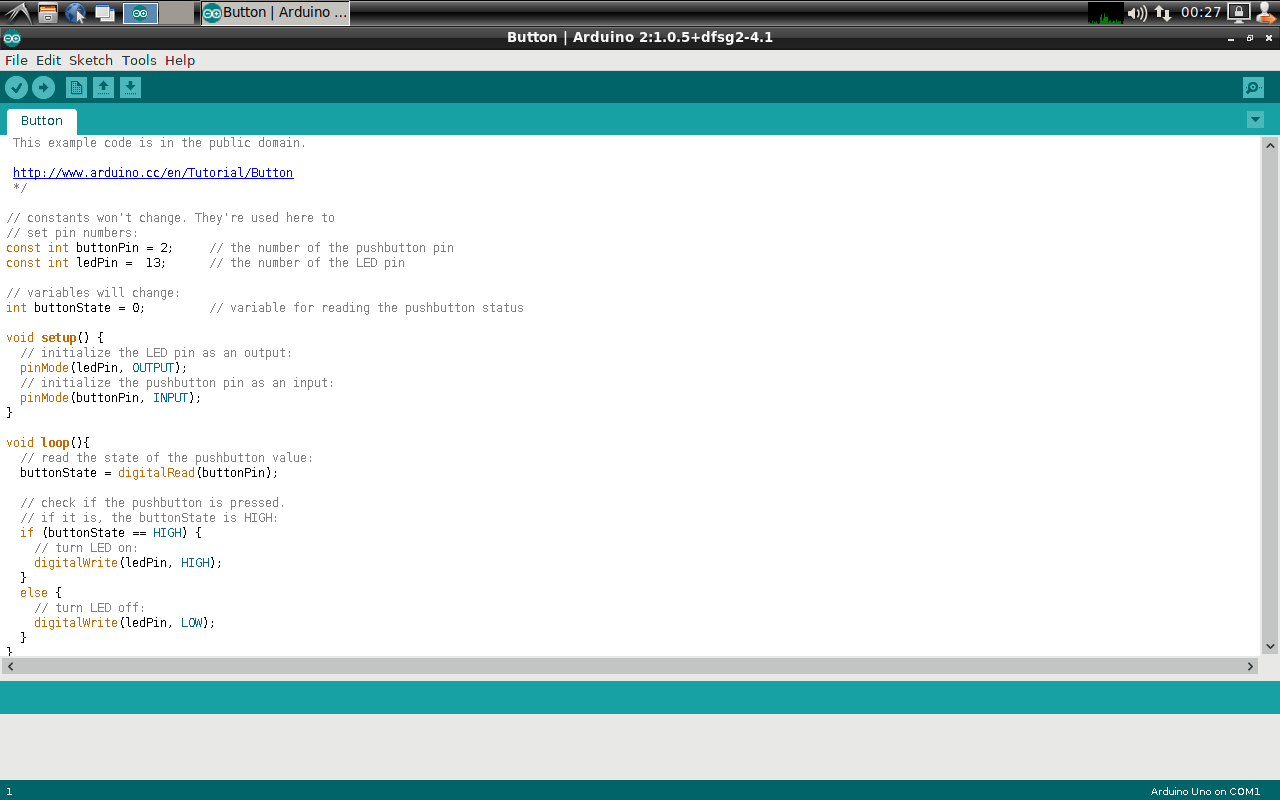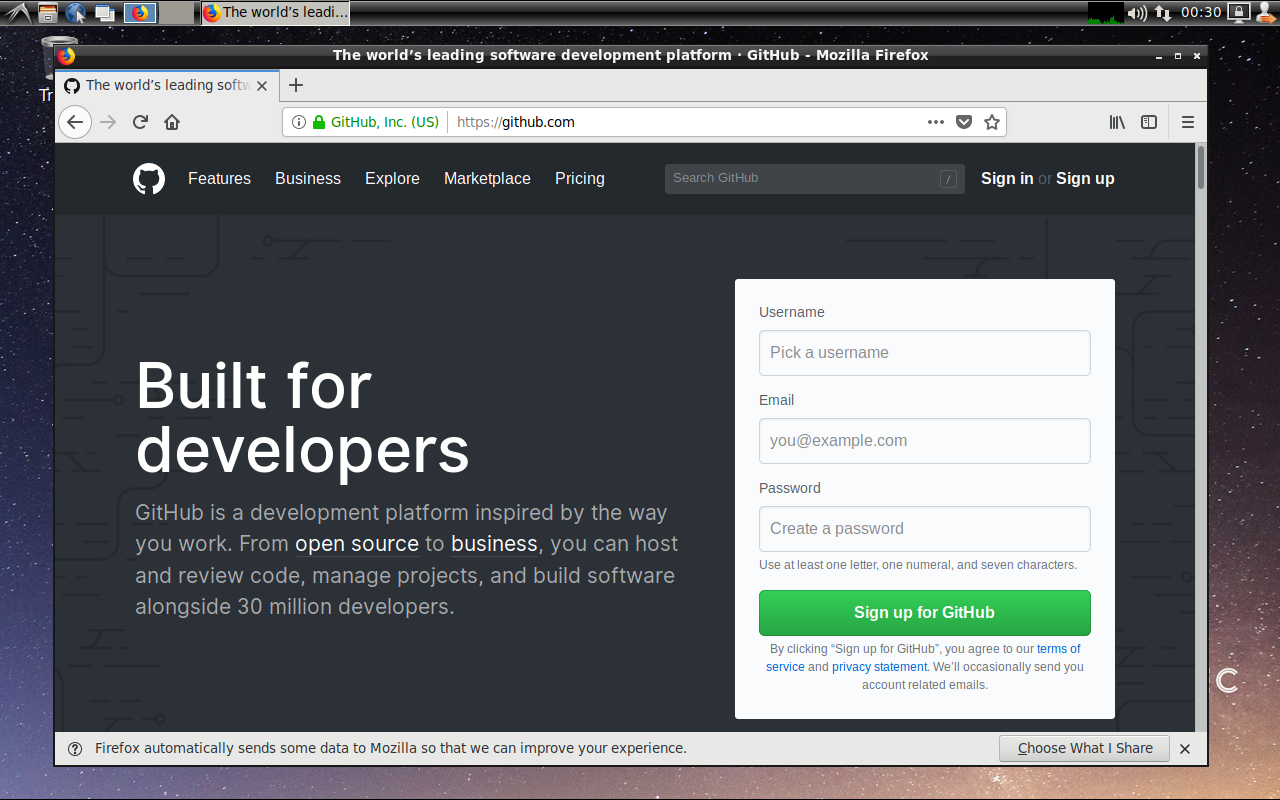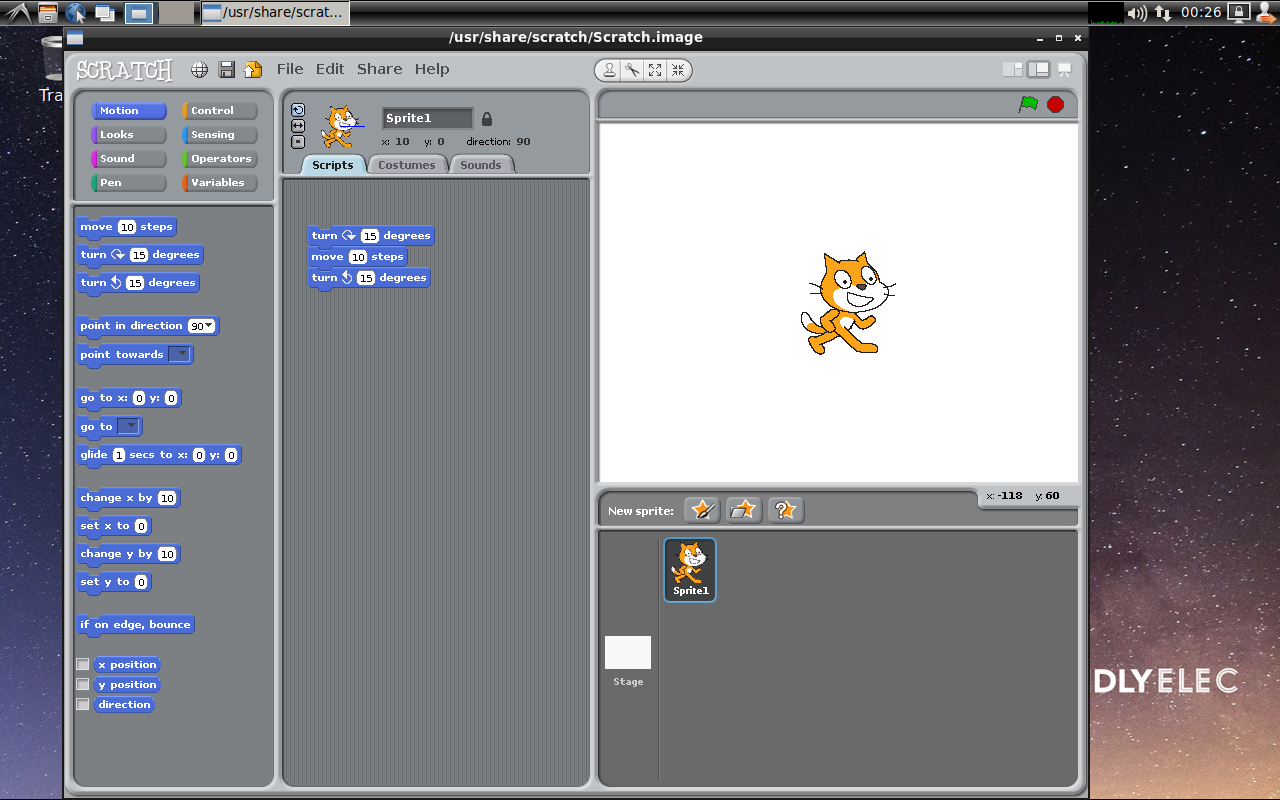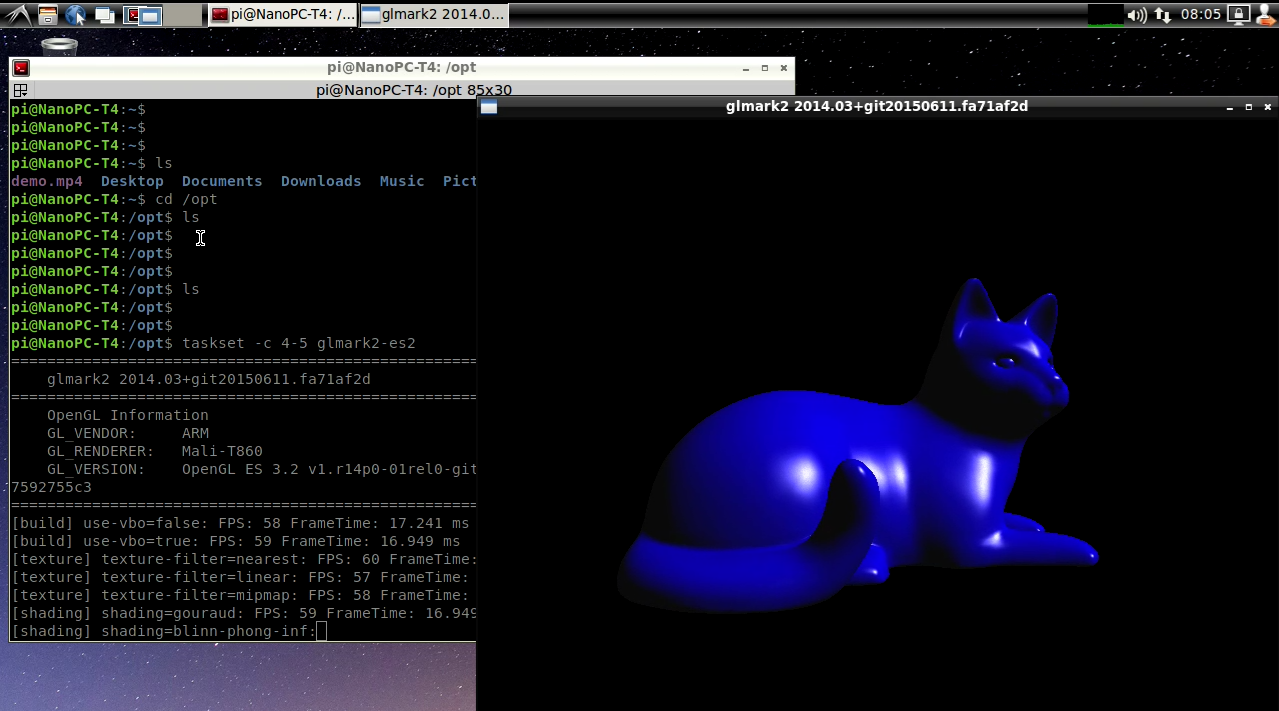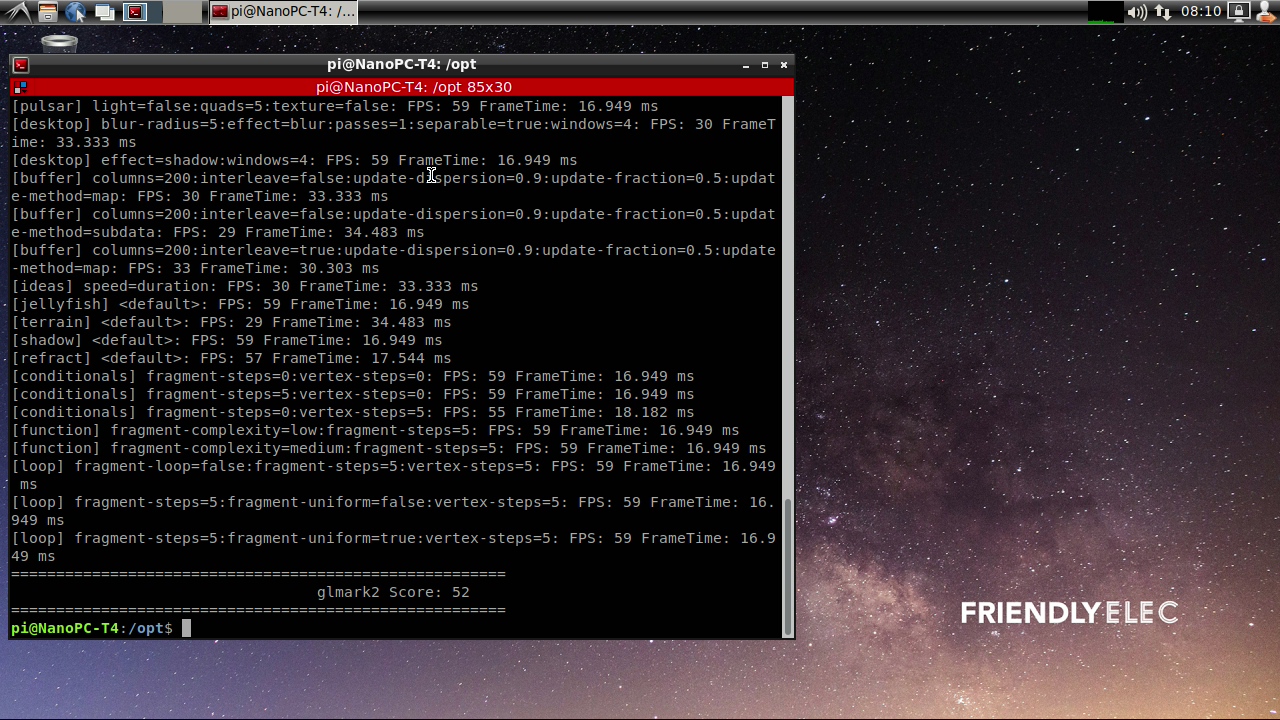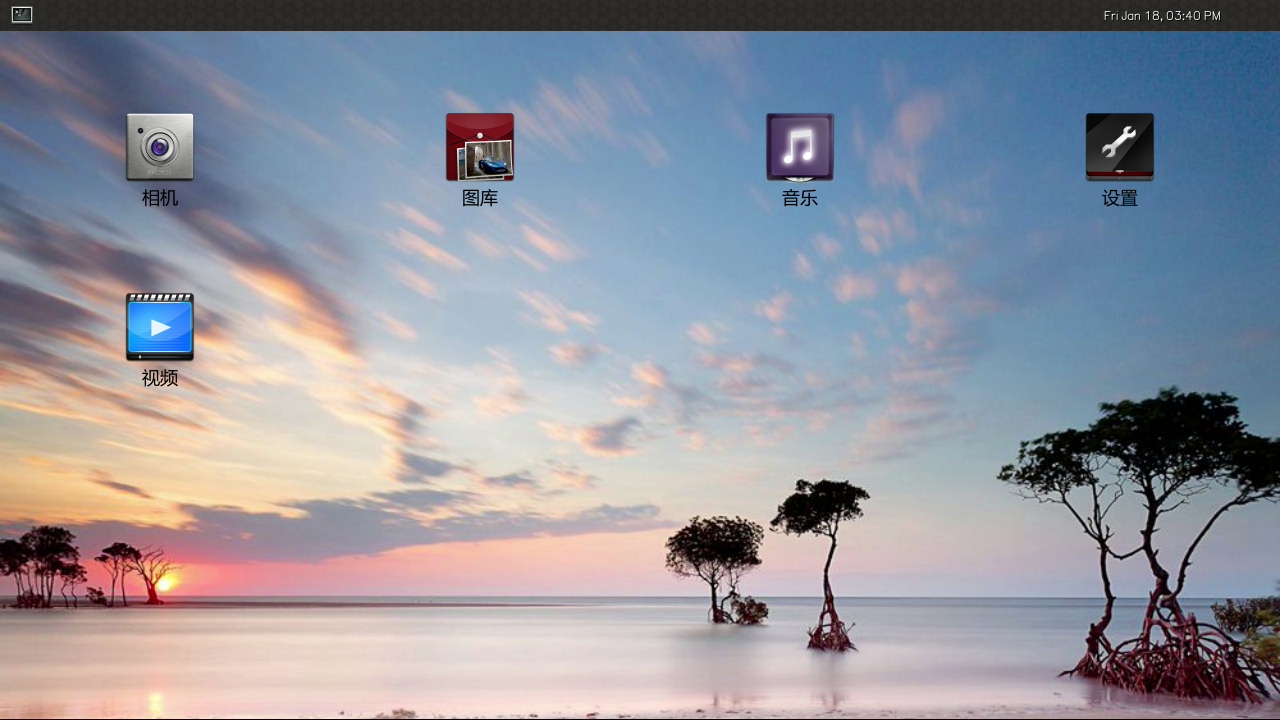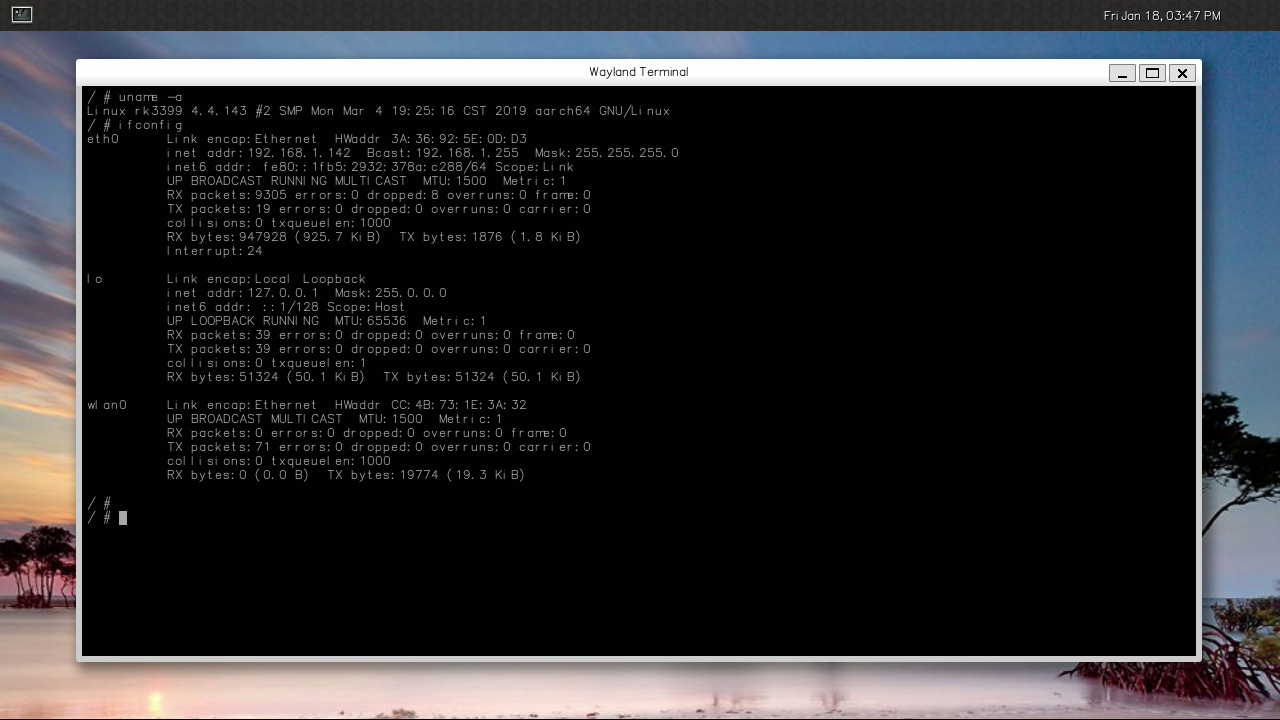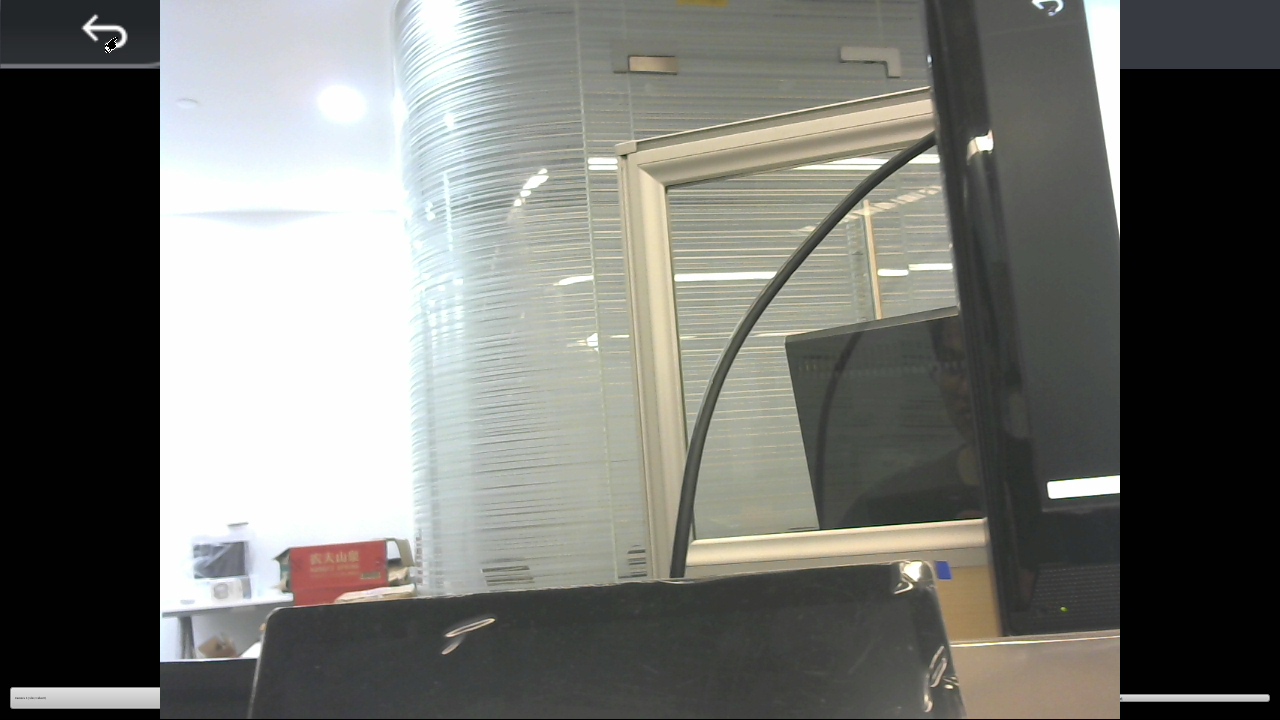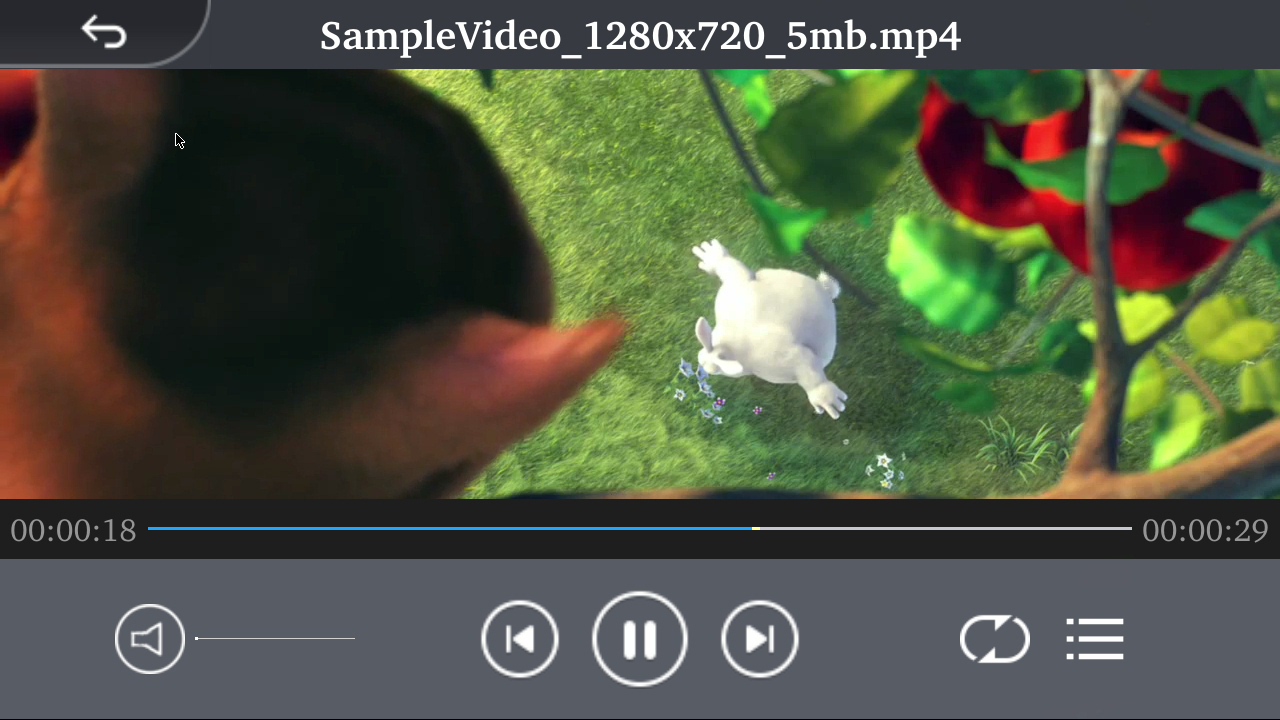Difference between revisions of "SOM-RK3399v2"
(updated by API) |
(updated by API) |
||
| Line 1,541: | Line 1,541: | ||
{{RK3399 Buildroot Intro|SOM-RK3399}} | {{RK3399 Buildroot Intro|SOM-RK3399}} | ||
<br /> | <br /> | ||
| − | For a more detailed description of the Buildroot system, please refer to: [[Buildroot | + | For a more detailed description of the Buildroot system, please refer to: [[Buildroot|Buildroot]]<br /> |
==Work with Lubuntu== | ==Work with Lubuntu== | ||
See here: [[Lubuntu desktop 16.04 for RK3399]]<br /> | See here: [[Lubuntu desktop 16.04 for RK3399]]<br /> | ||
Revision as of 09:17, 9 March 2022
Contents
- 1 Introduction
- 2 Hardware Spec
- 3 Diagram, Layout and Dimension
- 4 Carrier Board
- 5 Get Started
- 6 Access hardware
- 7 Work with FriendlyDesktop
- 7.1 Account & Password
- 7.2 WiFi Connection
- 7.3 HDMI/DP LCD Resolution
- 7.4 Adjust HDMI overscan
- 7.5 eDP LCD Display Rotation
- 7.6 Test OpenGL ES
- 7.7 4K Video Playing
- 7.8 Work with USB Camera
- 7.9 File Transfer with Bluetooth
- 7.10 Install OpenCV
- 7.11 Develop Qt Applications
- 7.12 WiringPi and Python Wrapper
- 7.13 Switch audio default output device
- 7.14 Play RTSP video stream (or IP Camera)
- 7.15 Chromium web browser
- 7.16 Screen saver and auto sleep related settings
- 7.17 Install Scratch
- 7.18 Install Arduino IDE
- 7.19 Start the program automatically at startup
- 7.20 Login to the desktop as the root user
- 7.21 Using NVME SSD on FriendlyDesktop
- 8 Work with FriendlyCore
- 8.1 Introduction
- 8.2 System Login
- 8.3 Configure System with npi-config
- 8.4 Develop Qt Application
- 8.5 Setup Program to AutoRun
- 8.6 Extend TF Card's Section
- 8.7 Transfer files using Bluetooth
- 8.8 WiFi
- 8.9 Ethernet Connection
- 8.10 Custom welcome message
- 8.11 Modify timezone
- 8.12 Select the system default audio device
- 8.13 Change the behavior of the PWM fan
- 8.14 Run the X11 application
- 8.15 Mpv hardware decoding video player
- 9 Features applicable to FriendlyDesktop and FriendlyCore
- 10 Connect NVME SSD High Speed Hard Disk
- 11 Buildroot Linux
- 12 Work with Lubuntu
- 13 Work with Android 8.1
- 13.1 Connect MIPI Camera to SOM-RK3399
- 13.2 Use dual MIPI camera preview and video
- 13.3 Change system language
- 13.4 Android8.1 hardware access
- 13.5 Android Neural Networks SDK Sample
- 13.6 Using the adb
- 13.7 HDMI resolution and overscan setting
- 13.8 Screen rotation
- 13.9 Hide Navigation bar
- 13.10 Switch audio output channel
- 13.11 Adjust the volume of the recording
- 13.12 Custom logo and boot animation
- 13.13 Remove Google Framework
- 13.14 Navigate Android with Remote Control
- 13.15 Work with USB Camera to Take Pictures and Record Video
- 13.16 Using 4G Module EC20 on Android
- 13.17 Using SSD on Android
- 13.18 Fan speed setting
- 14 Work with Android7.1
- 15 Make Your Own OS Image
- 15.1 Setup Development Environment
- 15.2 Install Cross Compiler
- 15.3 Build Openwrt/Friendlywrt
- 15.4 Build Buildroot
- 15.5 Build Other Linux
- 15.6 Build the code using scripts
- 15.7 Building AOSP from source
- 16 Using On-Board Hardware Resources
- 17 Source code repositories
- 18 More OS Support
- 19 Link to Rockchip Resources
- 20 Schematic, PCB CAD File
- 21 Update Log
- 21.1 2024-04-21
- 21.2 2024-03-15
- 21.3 2024-01-31
- 21.4 2023-12-01
- 21.5 2023-10-31
- 21.6 2023-07-01
- 21.7 2023-05-26
- 21.8 2023-05-21
- 21.9 2023-04-26
- 21.10 2023-02-10
- 21.11 2023-01-09
- 21.12 2022-12-04
- 21.13 2022-09-06
- 21.14 2022-08-19
- 21.15 2022-08-03
- 21.16 2022-07-27
- 21.17 2022-07-04
- 21.18 2021-12-02
- 21.19 2021-10-29
- 21.20 2021-08-31
- 21.21 2021-03-11
- 21.22 2020-12-24
- 21.23 2020-12-17
- 21.24 2020-10-27
- 21.25 2020-09-27
- 21.26 2020-09-16
- 21.27 2020-08-17
- 21.28 2020-07-10
- 21.29 2020-06-23
- 21.30 2020-03-24
- 21.31 2019-12-27
- 21.32 2019-09-26
- 21.33 2019-09-03
- 21.34 2019-07-18
- 21.35 2019-06-25
- 21.36 2019-05-23
- 21.37 2019-05-11
- 21.38 2019-03-08
- 21.39 2018-12-19
- 21.40 2018-11-12
- 21.41 2018-09-21
- 21.42 2018-09-05
1 Introduction
- The SOM-RK3399v2 is a 260-pin high performance ARM module designed and developed by FriendlyElec. It is based on Rockchip’s 64-bit hexa-core RK3399 SoC. The regular version has 4GB LPDDR4 RAM, 16GB Flash, onboard 2x2 MIMO dual-antenna WiFi module. Its dimension is 69.6 x 50 mm. It has a TypeC power port and USB-C display port, and can work by itself without a carrier board.
- The SOM-RK3399v2 module has various interfaces and ports. It can drive a 4-channel NVMe high speed SSD hard disk by working with a carrier board and the read/write rate can reach up to 1GB/s. It can drive dual-MIPI WDR cameras. It has an eDP interface, MIPI interface, USB 3.0, two USB 2.0 interfaces and other interfaces such as I2C, I2S, SPI, PWM, GPIO, serial and etc.
- The SOM-RK3399v2 can run popular OS systems such as Android 8.1, Ubuntu 18.04, Armbian and Buildroot smoothly. It has well established software support. Especially it has NN SDK packages for neural networks in Android 8.1, VPU hardware encoding/decoding in Qt-5.10, and GPU graphic acceleration. It supports development of dynamic GUI with Qt Quick. It is a perfect platform for startups to develop applications and prototypes in facial detection, machine vision, VR, autonomous-driving, deep learning, AI and etc.
2 Hardware Spec
- SoC: Rockchip RK3399
- CPU: big.LITTLE,Dual-Core Cortex-A72(up to 2.0GHz) + Quad-Core Cortex-A53(up to 1.5GHz)
- GPU: Mali-T864 GPU,supports OpenGL ES1.1/2.0/3.0/3.1, OpenCL, DX11, and AFBC
- VPU: 4K VP9 and 4K 10bits H265/H264 60fps decoding, Dual VOP, etc
- PMU: RK808-D PMIC, cooperated with independent DC/DC, enabling DVFS, software power-down, RTC wake-up, system sleep mode
- RAM: Dual-Channel 4GB LPDDR4
- Flash: 16GB eMMC 5.1 Flash
- Ethernet: Native Gigabit Ethernet
- Wi-Fi/BT: 802.11a/b/g/n/ac, Bluetooth 4.1, Wi-Fi and Bluetooth combo module, 2x2 MIMO, dual antenna interface
- Video Input: one or two 4-Lane MIPI-CSI, dual ISP, up to 13MPix/s,supports simultaneous input of dual camera data
- Video output
- HDMI: HDMI 2.0a, supports 4K@60Hz,HDCP 1.4/2.2
- DP on Type-C: DisplayPort 1.2 Alt Mode on USB Type-C
- LCD Interface: one eDP 1.3(4-Lane,10.8Gbps), one or two 4-Lane MIPI-DSI
- USB
- USB 2.0: 2 independent native USB 2.0 Host
- USB 3.0: 1 native USB 3.0 Host
- USB Type-C: Supports USB3.0 Type-C and DisplayPort 1.2 Alt Mode on USB Type-C
- PCIe: PCIe x4, compatible with PCIe 2.1, Dual operation mode;
- SDIO/MMC: 1x SDIO/MMC for SD Card
- GPIOs, I2S, I2C, PWM, UART, SPI, ADCs
- 2 X 1.8V I2C, 1 x 3V I2C
- 1 x 3V UART/SPI
- 2 x PWM
- 1 x IR-RX
- 1 x SPDIF_TX
- 1 x 1.8V I2S,
- 6 x 1.8V GPIOs, 8 x 3V GPIOs
- ADC: 3 x 1.8V ADC inputs
- Debug: one Debug UART, 3V level, 1500000bps
- Keys: PowerKey, Reset, Recovery
- LED: 1 x power LED and 1 x GPIO Controlled LED
- Power supply: DC 12V/1A
- PCB: 8 Layer, 50 mm x 69.6 mm, 260 Pin edge connector
- Ambient Operating Temperature: -20℃ to 70℃
3 Diagram, Layout and Dimension
- 260 Pin Spec
- Socket Type:0.5mm Pitch 260-Pin Standard Type DDR4 SODIMM Socket, refer to https://www.te.com/usa-en/product-2309409-5.html
| Top | Bottom | ||||||||
|---|---|---|---|---|---|---|---|---|---|
| Pin# | Assignment | Pin Type | If Not Use | Description | Pin# | Assignment | Pin Type | If Not Use | Description |
| 1 | VCC_IN | Power IN | / | 12V Power Input | 2 | VCC_IN | Power IN | / | 12V Power Input |
| 3 | VCC_IN | Power IN | / | 4 | VCC_IN | Power IN | / | ||
| 5 | VCC_IN | Power IN | / | 6 | VCC_IN | Power IN | / | ||
| 7 | VCC_IN | Power IN | / | 8 | VCC_IN | Power IN | / | ||
| 9 | GND | Power | / | System Ground(0V) | 10 | GND | Power | / | System Ground(0V) |
| 11 | GND | Power | / | 12 | GND | Power | / | ||
| 13 | VCC5V0_SYS | Power OUT | float | 5V Power Output,2A max. Auto on when system power on, and off when system power off. | 14 | PWR_KEY | In | float | System Power Key signal, active low, internal pulled up to 3.3V with 10K |
| 15 | VCC5V0_SYS | Power OUT | float | 16 | VDC_ONOFF | In | float | Power On Mode Select, float for Auto Start,short to GND for PowerKey Mode | |
| 17 | VCC5V0_SYS | Power OUT | float | 18 | RTC_BATT_IN | Power IN | float | RTC backup battery(3V)input,backup current is 25uA | |
| 19 | VCC5V0_SYS | Power OUT | float | 20 | RECOVERY | In | float | System RECOVERY Key signal,acticve low | |
| 21 | VCC3V3_SYS | Power OUT | float | 3.3V Power Output,1A max. Auto on when system power on, and off when system power off. | 22 | RESET_IN_H | In | float | RESET signal, acticve high |
| 23 | VCC3V3_SYS | Power OUT | float | 24 | GND | Power | / | System Ground(0V) | |
| 25 | VCC3V3_SYS | Power OUT | float | 26 | ADC_IN0 | In | float | 0V to 1.8V inputs of RK3399 SoC ADC | |
| 27 | VCC3V3_SYS | Power OUT | float | 28 | ADC_IN2 | In | float | ||
| 29 | VCC_1V8 | Power OUT | float | 1.8V Power Output,200mA max. Auto on when system power on, and off when system power off. | 30 | ADC_IN3 | In | float | |
| 31 | VCC_1V8 | Power OUT | float | 32 | GND | Power | / | System Ground(0V) | |
| 33 | VCC3V3_S3 | Power OUT | float | 3.3V Power Output,100mA max. Auto on when system power on, and off when system sleep or power off. | 34 | GPIO1_A0 | In/Out | float | 3V GPIO. Linux GPIO 32 |
| 35 | GND | Power | / | System Ground(0V) | 36 | GPIO1_A1 | In/Out | float | 3V GPIO. Linux GPIO 33 |
| 37 | GPIO0_A2 | In/Out | float | 1.8V GPIO. Linux GPIO 2 | 38 | GPIO1_A3 | In/Out | float | 3V GPIO. Linux GPIO 35 |
| 39 | GPIO2_A2 | In/Out | float | 1.8V GPIO. Linux GPIO 66 | 40 | GPIO1_A4 | In/Out | float | 3V GPIO. Linux GPIO 36 |
| 41 | GPIO2_A3 | In/Out | float | 1.8V GPIO. Linux GPIO 67 | 42 | GPIO1_C2 | In/Out | float | 3V GPIO . Linux GPIO 50 |
| 43 | GPIO2_A4 | In/Out | float | 1.8V GPIO. Linux GPIO 68 | 44 | GPIO1_C6 | In/Out | float | 3V GPIO. Linux GPIO 54 |
| 45 | GPIO2_A5 | In/Out | float | 1.8V GPIO. Linux GPIO 69 | 46 | GPIO1_C7 | In/Out | float | 3V GPIO . Linux GPIO 55 |
| 47 | GPIO2_A6 | In/Out | float | 1.8V GPIO. Linux GPIO 70 | 48 | GPIO1_D0 | In/Out | float | 3V GPIO . Linux GPIO 56 |
| 49 | IR_RX | In | float | Infrared Receiver input, 1.8V level | 50 | GPIO4_C5/SPDIF_TX | In/Out | float | 3V GPIO . Linux GPIO 149. or SPDIF Output |
| 51 | GND | Power | / | System Ground(0V) | 52 | UART2DBG_TX | Out | float | Debug UART TX, 1500000bps, 3V level |
| 53 | I2C1_SCL | Out | float | I2C1 clock, 1.8V level, open drian with 2.2K pulled internal | 54 | UART2DBG_RX | In | float | Debug UART RX, 1500000bps, 3V level |
| 55 | I2C1_SDA | In/Out | float | I2C1 data, 1.8V level, open drian with 2.2K pulled internal | 56 | SPI1_CSn0 | Out | float | SPI1 chip select, 3V level |
| 57 | I2C2_SDA | In/Out | float | I2C2 data, 1.8V level, open drian with 2.2K pulled internal | 58 | SPI1_TXD/UART4_TX | Out | float | SPI1 MOSI, or UART4 TX,3V level |
| 59 | I2C2_SCL | Out | float | I2C2 clock, 1.8V level, open drian with 2.2K pulled internal | 60 | SPI1_RXD/UART4_RX | In | float | SPI1 MISO, or UART4 RX,3V level |
| 61 | I2C7_SCL_HDMI | Out | float | I2C7 clock, 1.8V level, for HDMI EDID CLK, open drian with 2.2K pulled internal | 62 | SPI1_CLK | Out | float | SPI1 Clock, 3V level |
| 63 | I2C7_SDA_HDMI | In/Out | float | I2C7 data, 1.8V level, for HDMI EDID DATA, open drian with 2.2K pulled internal | 64 | GND | Power | / | System Ground(0V) |
| 65 | GND | Power | / | System Ground(0V) | 66 | GPIO4_C1/I2C3_SCL | In/Out | float | I2C3 clock, 3V level,open drian. or GPIO,Linux GPIO 145 |
| 67 | I2S0_SCLK | Out | float | I2S0 continuous serial clock, 1.8V level | 68 | GPIO4_C0/I2C3_SDA | In/Out | float | I2C3 data, 3V level,open drian. or GPIO,Linux GPIO 144 |
| 69 | I2S0_LRCK_RX | Out | float | I2S0 word select for input data, 1.8V level | 70 | I2C4_TPSCL | Out | float | I2C4 clock,3V level, open drian with 2.2K pulled up,for touch panel |
| 71 | I2S0_LRCK_TX | Out | float | I2S0 word select for output data, 1.8V level | 72 | I2C4_TPSDA | In/Out | float | I2C4 data,3V level, open drian with 2.2K pulled up,for touch panel |
| 73 | I2S0_SDI0 | In | float | I2S0 serial data, 1.8V level | 74 | GND | Power | / | System Ground(0V) |
| 75 | I2S0_SDI1SDO3 | In/out | float | I2S0 serial data, 1.8V level | 76 | HP_DET_H | In | Pull up to VCC3V3_SYS | headphone insert detect, active high |
| 77 | I2S0_SDI2SDO2 | In/out | float | I2S0 serial data, 1.8V level | 78 | GPIO4_D5_LCD_BL_EN | Out | float | LCD backlight on/off control, active high, 3V level |
| 79 | I2S0_SDI3SDO1 | In/out | float | I2S0 serial data, 1.8V level | 80 | GPIO4_D6_LCD_RST_H | Out | float | LCD reset, active high, 3V level. |
| 81 | I2S0_SDO0 | out | float | I2S0 serial data, 1.8V level | 82 | GPIO1_B5_TP_RST | Out | float | Touch panel reset, active low, 3V level |
| 83 | GND | Power | / | System Ground(0V) | 84 | GPIO1_C4_TP_INT | In | float | Touch panel IRQ, active low, 3V level |
| 85 | I2S_CLK | out | float | I2S Mclk for I2S0 and I2S1 | 86 | GND | Power | / | System Ground(0V) |
| 87 | GND | Power | / | System Ground(0V) | 88 | PWM0_BL | Out | float | PWM0 for LCD backlight dimming |
| 89 | I2S1_SCLK | Out | float | I2S1 continuous serial clock, 1.8V level | 90 | GPIO4_C6/PWM1 | Out | float | PWM1 for cooling fan control |
| 91 | 2S1_LRCK_RX | Out | float | I2S1 word select for input data, 1.8V level | 92 | GND | Power | / | System Ground(0V) |
| 93 | I2S1_LRCK_TX | Out | float | I2S1 word select for output data, 1.8V level | 94 | VCC3V0_SD | Power Out | float | 3V power out for SD card. |
| 95 | I2S1_SDI0 | In | float | I2S0 serial data, 1.8V level | 96 | GND | Power | / | System Ground(0V) |
| 97 | I2S1_SDO0 | Out | float | I2S0 serial data, 1.8V level | 98 | SDMMC0_D0 | In/Out | float | SD card Data0 |
| 99 | MIPI_CSI0_RST | Out | float | Camera Reset for MIPI CSI0, 1.8V level | 100 | SDMMC0_D1 | In/Out | float | SD card Data1 |
| 101 | MIPI_CSI0_PWN | Out | float | Camera Power Down for MIPI CSI0, 1.8V level | 102 | SDMMC0_D2 | In/Out | float | SD card Data2 |
| 103 | MIPI_CSI1_RST | Out | float | Camera Reset for MIPI CSI1, 1.8V level | 104 | SDMMC0_D3 | In/Out | float | SD card Data3 |
| 105 | MIPI_CSI1_PWN | Out | float | Camera Power Down for MIPI CSI1, 1.8V level | 106 | SDMMC0_CMD | Out | float | SD card CMD |
| 107 | VCC1V8_CAM | Power Out | float | Power Out for Camera IO | 108 | SDMMC0_DET_L | In | float | SD card detect |
| 109 | GND | Power | / | System Ground(0V) | 110 | GND | Power | / | System Ground(0V) |
| 111 | GPIO2_B3_CIF_CLKOUTA | Out | float | MCLK for camera sensor | 112 | SDMMC0_CLK | Out | float | SD card Clock |
| 113 | GND | Power | / | System Ground(0V) | 114 | GND | Power | / | System Ground(0V) |
| 115 | MIPI_RX0_D3N | In | float | MIPI CSI0 negative differential data line | 116 | MIPI_TX1/RX1_D0N | In/Out | float | MIPI CSI1/DSI1 negative differential data line |
| 117 | MIPI_RX0_D3P | In | float | MIPI CSI0
positive differential data line |
118 | MIPI_TX1/RX1_D0P | In/Out | float | MIPI CSI1/DSI1
positive differential data line |
| 119 | GND | Power | / | System Ground(0V) | 120 | GND | Power | / | System Ground(0V) |
| 121 | MIPI_RX0_D2N | In | float | MIPI CSI0 negative differential data line | 122 | MIPI_TX1/RX1_D1N | In/Out | float | MIPI CSI1/DSI1 negative differential data line |
| 123 | MIPI_RX0_D2P | In | float | MIPI CSI0
positive differential data line |
124 | MIPI_TX1/RX1_D1P | In/Out | float | MIPI CSI1/DSI1
positive differential data line |
| 125 | GND | Power | / | System Ground(0V) | 126 | GND | Power | / | System Ground(0V) |
| 127 | MIPI_RX0_CLKN | In | float | MIPI CSI0 negative differential clock line | 128 | MIPI_TX1/RX1_CLKN | In/Out | float | MIPI CSI1/DSI1 negative differential clock line |
| 129 | MIPI_RX0_CLKP | In | float | MIPI CSI0
positive differential clock line |
130 | MIPI_TX1/RX1_CLKP | In/Out | float | MIPI CSI1/DSI1
positive differential clock line |
| 131 | GND | Power | / | System Ground(0V) | 132 | GND | Power | / | System Ground(0V) |
| 133 | MIPI_RX0_D1N | In | float | MIPI CSI0 negative differential data line | 134 | MIPI_TX1/RX1_D2N | In/Out | float | MIPI CSI1/DSI1 negative differential data line |
| 135 | MIPI_RX0_D1P | In | float | MIPI CSI0
positive differential data line |
136 | MIPI_TX1/RX1_D2P | In/Out | float | MIPI CSI1/DSI1
positive differential data line |
| 137 | GND | Power | / | System Ground(0V) | 138 | GND | Power | / | System Ground(0V) |
| 139 | MIPI_RX0_D0N | In | float | MIPI CSI0 negative differential data line | 140 | MIPI_TX1/RX1_D3N | In/Out | float | MIPI CSI1/DSI1 negative differential data line |
| 141 | MIPI_RX0_D0P | In | float | MIPI CSI0
positive differential data line |
142 | MIPI_TX1/RX1_D3P | In/Out | float | MIPI CSI1/DSI1
positive differential data line |
| 143 | GND | Power | / | System Ground(0V) | 144 | GND | Power | / | System Ground(0V) |
| Connector Key | Connector Key | ||||||||
| 145 | HDMI_CEC | In/Out | float | HDMI CEC signal, 3V level | 146 | GND | Power | / | System Ground(0V) |
| 147 | HDMI_HPD | In | float | HDMI hot plug | 148 | MIPI_TX0_D3N | Out | float | MIPI DSI0 negetive differential data line |
| 149 | GND | Power | / | System Ground(0V) | 150 | MIPI_TX0_D3P | Out | float | MIPI DSI0 positive differential data line |
| 151 | HDMI_TXCN | Out | float | HDMI differential clock line negative | 152 | GND | Power | / | System Ground(0V) |
| 153 | HDMI_TXCP | Out | float | HDMI differential clock line positive | 154 | MIPI_TX0_D2N | Out | float | MIPI DSI0 negetive differential data line |
| 155 | GND | Power | / | System Ground(0V) | 156 | MIPI_TX0_D2P | Out | float | MIPI DSI0 positive differential data line |
| 157 | HDMI_TX0N | Out | float | HDMI differential data line negative | 158 | GND | Power | / | System Ground(0V) |
| 159 | HDMI_TX0P | Out | float | HDMI differential data line positive | 160 | MIPI_TX0_CLKN | Out | float | MIPI DSI0 negetive differential clock line |
| 161 | GND | Power | / | System Ground(0V) | 162 | MIPI_TX0_CLKP | Out | float | MIPI DSI0 positive differential clock line |
| 163 | HDMI_TX1N | Out | float | HDMI differential data line negative | 164 | GND | Power | / | System Ground(0V) |
| 165 | HDMI_TX1P | Out | float | HDMI differential data line positive | 166 | MIPI_TX0_D1N | Out | float | MIPI DSI0 negetive differential data line |
| 167 | GND | Power | / | System Ground(0V) | 168 | MIPI_TX0_D1P | Out | float | MIPI DSI0 positive differential data line |
| 169 | HDMI_TX2N | Out | float | HDMI differential data line negative | 170 | GND | Power | / | System Ground(0V) |
| 171 | HDMI_TX2P | Out | float | HDMI differential data line positive | 172 | MIPI_TX0_D0N | Out | float | MIPI DSI0 negetive differential data line |
| 173 | GND | Power | / | System Ground(0V) | 174 | MIPI_TX0_D0P | Out | float | MIPI DSI0 positive differential data line |
| 175 | USB3.0/TYPE-C1_DP | In/Out | float | TYPEC1 USB 2.0 data+ | 176 | GND | Power | / | System Ground(0V) |
| 177 | USB3.0/TYPE-C1_DM | In/Out | float | TYPEC1 USB 2.0 data- | 178 | PCIE_RX3_N | In | float | PCIe negative differential data line |
| 179 | GND | Power | / | System Ground(0V) | 180 | PCIE_RX3_P | In | float | PCIe positive differential data line |
| 181 | USB3.0/TYPEC1_TX1P | Out | float | TYPEC1 USB3.0 PHY0 SuperSpeed TX1P | 182 | GND | Power | / | System Ground(0V) |
| 183 | USB3.0/TYPEC1_TX1M | Out | float | TYPEC1 USB3.0 PHY0 SuperSpeed TX1M | 184 | PCIE_TX3N | Out | float | PCIe negative differential data line |
| 185 | GND | Power | / | System Ground(0V) | 186 | PCIE_TX3P | Out | float | PCIe positive differential data line |
| 187 | USB3.0/TYPEC1_RX1P | In | float | TYPEC1 USB3.0 PHY0 SuperSpeed RX1P | 188 | GND | Power | / | System Ground(0V) |
| 189 | USB3.0/TYPEC1_RX1M | In | float | TYPEC1 USB3.0 PHY0 SuperSpeed RX1M | 190 | PCIE_RX2_N | In | float | PCIe negative differential data line |
| 191 | GND | Power | / | System Ground(0V) | 192 | PCIE_RX2_P | In | float | PCIe positive differential data line |
| 193 | TYPEC1_TX2P | Out | float | TYPEC1 USB3.0 PHY0 SuperSpeed TX2P | 194 | GND | Power | / | System Ground(0V) |
| 195 | TYPEC1_TX2M | Out | float | TYPEC1 USB3.0 PHY0 SuperSpeed TX2M | 196 | PCIE_TX2N | Out | float | PCIe negative differential data line |
| 197 | GND | Power | / | System Ground(0V) | 198 | PCIE_TX2P | Out | float | PCIe positive differential data line |
| 199 | TYPEC1_RX2P | In | float | TYPEC1 USB3.0 PHY0 SuperSpeed RX2P | 200 | GND | Power | / | System Ground(0V) |
| 201 | TYPEC1_RX2M | In | float | TYPEC1 USB3.0 PHY0 SuperSpeed RX2M | 202 | PCIE_RX1_N | In | float | PCIe negative differential data line |
| 203 | GND | Power | / | System Ground(0V) | 204 | PCIE_RX1_P | In | float | PCIe positive differential data line |
| 205 | TYPEC1_SBU1 | In/Out | float | TYPEC1 SBU1 | 206 | GND | Power | / | System Ground(0V) |
| 207 | TYPEC1_SBU2 | In/Out | float | TYPEC1 SBU2 | 208 | PCIE_TX1N | Out | float | PCIe negative differential data line |
| 209 | GND | Power | / | System Ground(0V) | 210 | PCIE_TX1P | Out | float | PCIe positive differential data line |
| 211 | TYPEC1_SBU1_DC | Out | float | TYPEC1 SBU1 DC Bias | 212 | GND | Power | / | System Ground(0V) |
| 213 | TYPEC1_SBU2_DC | Out | float | TYPEC1 SBU2 DC Bias | 214 | PCIE_RX0_N | In | float | PCIe negative differential data line |
| 215 | TYPEC1_U2VBUSDET | In | float | TYPEC1 Vbus detect | 216 | PCIE_RX0_P | In | float | PCIe positive differential data line |
| 217 | GND | Power | / | System Ground(0V) | 218 | GND | Power | / | System Ground(0V) |
| 219 | HOST0_DP | In/Out | float | USB 2.0 Host0 data+ | 220 | PCIE_TX0N | Out | float | PCIe negative differential data line |
| 221 | HOST0_DM | In/Out | float | USB 2.0 Host0 data- | 222 | PCIE_TX0P | Out | float | PCIe positive differential data line |
| 223 | GND | Power | / | System Ground(0V) | 224 | GND | Power | / | System Ground(0V) |
| 225 | HOST1_DP | In/Out | float | USB 2.0 Host1 data+ | 226 | PCIE_REF_CLKN | Out | float | PCIe negative differential reference clock line |
| 227 | HOST1_DM | In/Out | float | USB 2.0 Host1 data- | 228 | PCIE_REF_CLKP | Out | float | PCIe positive differential reference clock line |
| 229 | GND | Power | / | System Ground(0V) | 230 | GND | Power | / | System Ground(0V) |
| 231 | EDP_TX3N | Out | float | eDP data line negative | 232 | LAN_LED0_BLINK | Out | float | 10/100/1000M Ethernet Status LED0 |
| 233 | EDP_TX3P | Out | float | eDP data line positive | 234 | LAN_LED1_LINK | Out | float | 10/100/1000M Ethernet Status LED1 |
| 235 | GND | Power | / | System Ground(0V) | 236 | GND | Power | / | System Ground(0V) |
| 237 | EDP_TX2N | Out | float | eDP data line negative | 238 | MDI3- | In/Out | float | 10/100/1000M Ethernet MDI3- |
| 239 | EDP_TX2P | Out | float | eDP data line positive | 240 | MDI3+ | In/Out | float | 10/100/1000M Ethernet MDI3+ |
| 241 | GND | Power | / | System Ground(0V) | 242 | GND | Power | / | System Ground(0V) |
| 243 | EDP_TX1N | Out | float | eDP data line negative | 244 | MDI2- | In/Out | float | 10/100/1000M Ethernet MDI2- |
| 245 | EDP_TX1P | Out | float | eDP data line positive | 246 | MDI2+ | In/Out | float | 10/100/1000M Ethernet MDI2+ |
| 247 | GND | Power | / | System Ground(0V) | 248 | GND | Power | / | System Ground(0V) |
| 249 | EDP_TX0N | Out | float | eDP data line negative | 250 | MDI1- | In/Out | float | 10/100/1000M Ethernet MDI1- |
| 251 | EDP_TX0P | Out | float | eDP data line positive | 252 | MDI1+ | In/Out | float | 10/100/1000M Ethernet MDI1+ |
| 253 | GND | Power | / | System Ground(0V) | 254 | GND | Power | / | System Ground(0V) |
| 255 | EDP_AUXP | In/Out | float | eDP AUX line positive | 256 | MDI0- | In/Out | float | 10/100/1000M Ethernet MDI0- |
| 257 | EDP_AUXN | In/Out | float | eDP AUX line negative | 258 | MDI0+ | In/Out | float | 10/100/1000M Ethernet MDI0+ |
| 259 | GND | Power | / | System Ground(0V) | 260 | GND | Power | / | System Ground(0V) |
4 Carrier Board
5 Get Started
5.1 Essentials You Need
Before starting to use your SOM-RK3399 get the following items ready
- SOM-RK3399
- Type-C cable
- TF Card: Class 10 or Above, minimum 8GB SDHC
- USB to serial adapter(optinal, for debugging or access from PC host)
- A DC 12V/2A power is a must
- HDMI monitor or LCD
- USB keyboard, mouse and possible a USB hub(or a TTL to serial board)
- A host computer running Ubuntu 18.04 64-bit system
6 Access hardware
6.1 Access Serial Interface
For now only UART4 is available for users:
Serial Interface Serial Device UART0 Used by Bluetooth UART1 Used by Gbps Ethernet UART2 Used by Serial Debug Port UART3 Used by Gbps Ethernet UART4 Available, device name is /dev/ttyS4 (note: this is only applicable for ROM released after 20180618)
6.2 Flash Image to eMMC
6.2.1 Download Image and Utilities
Visit download link to download image files and utilities.
| Android OS | |
| rk3399-eflasher-android10-YYYYMMDD.img.zip | Android10 image file |
| rk3399-eflasher-android8-YYYYMMDD.img.zip | Android8.1 image file |
| rk3399-eflasher-android7-YYYYMMDD.img.zip | Android7.1.2 image file |
| Linux OS | |
| rk3399-eflasher-debian-bullseye-core-4.19-arm64-YYYYMMDD.img.gz | Debian 11(Bullseye) Core No desktop environment, command line only Kernel version 4.19.y |
| rk3399-eflasher-debian-buster-desktop-arm64-YYYYMMDD.img.gz | Debian 10(buster) Desktop, Uses LXDE as default desktop, Supports hardware acceleration, Kernel version 4.19.y |
| rk3399-eflasher-buildroot-4.19-arm64-YYYYMMDD.img.gz | Buildroot image file with Qt5-wayland (base on Rockchip Linux SDK) |
| rk3399-eflasher-friendlydesktop-bionic-4.4-arm64-YYYYMMDD.img.zip | 64-bit FriendlyDesktop image file based on Ubuntu desktop 18.04 64bit |
| rk3399-eflasher-friendlycore-focal-4.19-arm64-YYYYMMDD.img.gz | 64-bit FriendlyCore image file(Qt 5.10.0) based on Ubuntu core 20.04 64bit |
| rk3399-eflasher-friendlycore-bionic-4.4-arm64-YYYYMMDD.img.gz | 64-bit FriendlyCore image file(Qt 5.10.0) based on Ubuntu core 18.04 64bit |
| rk3399-eflasher-lubuntu-desktop-xenial-4.4-armhf-YYYYMMDD.img.zip | Lubuntu Desktop(with Qt 5.10.0) |
| Linux Lite OS | |
| rk3399-eflasher-friendlycore-lite-focal-5.10-arm64-20211029.img.zip | 64-bit FriendlyCore Lite image file based on Ubuntu core 20.04 64bit, kernel version 5.15.y |
| rk3399-eflasher-friendlycore-lite-focal-4.19-arm64-20211029.img.zip | 64-bit FriendlyCore Lite image file based on Ubuntu core 20.04 64bit, kernel version 4.19.y |
| FriendlyWrt | |
| rk3399-eflasher-friendlywrt-21.02-YYYYMMDD.img.gz | FriendlyWrt image file, based on OpenWrt 21.02, kernel version 5.15.y |
| rk3399-eflasher-friendlywrt-21.02-docker-YYYYMMDD.img.gz | FriendlyWrt image file,based on OpenWrt 21.02, Pre-installed Docker,kernel version 5.15.y |
| rk3399-eflasher-friendlywrt-22.03-YYYYMMDD.img.gz | FriendlyWrt image file,based on OpenWrt 22.03,kernel version 5.15.y |
| rk3399-eflasher-friendlywrt-22.03-docker-YYYYMMDD.img.gz | FriendlyWrt image file,based on OpenWrt 22.03, Pre-installed Docker,kernel version 5.15.y |
| rk3399-eflasher-friendlywrt-kernel4-YYYYMMDD.img.zip | FriendlyWrt image file, based on OpenWrt 21.02, kernel version 4.19.y |
| Flash Utility: | |
| win32diskimager.rar | Windows utility. Under Linux users can use "dd" |
6.2.2 Flash Image to eMMC with eflasher and SD card
- Get an 8G SDHC card and backup its data if necessary;
- Download and extract the rk3399-eflasher-OSNAME-YYYYMMDD.img.zip and win32diskimager;
- Run the win32diskimager utility under Windows as administrator. On the utility's main window select your SD card's drive, the wanted image file EFlasher and click on "write" to start flashing the SD card. Under Linux run "dd" to flash the rk3399-eflasher-OSNAME-YYYYMMDD.img file to your SD card;
- Take out the SD and insert it to SOM-RK3399's microSD card slot;
- Power on SOM-RK3399 and it will be booted from your SD card and the EFlasher utility will be automatically launched. You can work with the EFlasher in multiple ways:
1: Connect an HDMI monitor and a USB mouse to your board and work with EFlasher's GUI;
2: Connect your board to a LAN, login onto the board with SSH and type "eflasher" in a commandline utility and proceed with prompts;(Note: when you login with SSH the username is root and the password is fa. Your board's IP address can be found by checking the router's system)
3: Login onto your board via a serial terminal and type "eflasher" to proceed;
4: Connect a lcd2usb to SOM-RK3399, press the K1 button on the LCD2USB board to select your wanted OS and press the K2 button to confirm. The installation process will be shown on lcd2usb;
- After installation is done turn off the board and take out the SD card from SOM-RK3399, power on the board and it will be booted from eMMC;
6.2.3 Flash Image under Windows with Type-C Cable
Visit download link to download Windows utilities and image files:
| Android OS | |
| rk3399-usb-android10-YYYYMMDD.img.zip | Android10 image file |
| rk3399-usb-android8-YYYYMMDD.img.zip | Android8.1 image file |
| rk3399-usb-android7-YYYYMMDD.img.zip | Android7.1.2 image file |
| Linux OS | |
| rk3399-usb-debian-bullseye-core-arm64-YYYYMMDD.img.gz | Debian 11(Bullseye) Core No desktop environment, command line only Kernel version 4.19.y |
| rk3399-usb-debian-bullseye-minimal-arm64-YYYYMMDD.img.gz | Debian 11(Bullseye) Desktop Uses LXDE as default desktop No pre-installed recommended software Supports hardware acceleration Kernel version 4.19.y |
| rk3399-usb-debian-bullseye-desktop-arm64-YYYYMMDD.img.gz | Debian 11(Bullseye) Desktop Uses LXDE as default desktop Pre-installed mpv, smplayer and chromium brower Supports hardware acceleration Kernel version 4.19.y |
| rk3399-usb-buildroot-4.19-arm64-YYYYMMDD.img.zip | Buildroot image file with Qt5-wayland (base on Rockchip Linux SDK) |
| rk3399-usb-friendlydesktop-bionic-4.4-arm64-YYYYMMDD.img.zip | 64-bit FriendlyDesktop image file based on Ubuntu desktop 18.04 64bit |
| rk3399-usb-friendlycore-focal-4.19-arm64-YYYYMMDD.img.zip | 64-bit FriendlyCore image file(Qt 5.10.0) based on Ubuntu core 20.04 64bit |
| rk3399-usb-friendlycore-bionic-4.4-arm64-YYYYMMDD.img.zip | 64-bit FriendlyCore image file(Qt 5.10.0) based on Ubuntu core 18.04 64bit |
| rk3399-usb-lubuntu-desktop-xenial-4.4-armhf-YYYYMMDD.img.zip | Lubuntu Desktop(with Qt 5.10.0) |
| Linux Lite OS | |
| rk3399-usb-friendlycore-lite-focal-5.10-arm64-20211029.img.zip | 64-bit FriendlyCore Lite image file based on Ubuntu core 20.04 64bit, kernel version 5.15.y |
| rk3399-usb-friendlycore-lite-focal-4.19-arm64-20211029.img.zip | 64-bit FriendlyCore Lite image file based on Ubuntu core 20.04 64bit, kernel version 4.19.y |
| FriendlyWrt | |
| rk3399-usb-friendlywrt-21.02-YYYYMMDD.img.gz | FriendlyWrt image file, based on OpenWrt 21.02, kernel version 5.15.y |
| rk3399-usb-friendlywrt-21.02-docker-YYYYMMDD.img.gz | FriendlyWrt image file,based on OpenWrt 21.02, Pre-installed Docker,kernel version 5.15.y |
| rk3399-usb-friendlywrt-22.03-YYYYMMDD.img.gz | FriendlyWrt image file,based on OpenWrt 22.03,kernel version 5.15.y |
| rk3399-usb-friendlywrt-22.03-docker-YYYYMMDD.img.gz | FriendlyWrt image file,based on OpenWrt 22.03, Pre-installed Docker,kernel version 5.15.y |
| rk3399-usb-friendlywrt-kernel4-YYYYMMDD.img.zip | FriendlyWrt image file, based on OpenWrt 21.02, kernel version 4.19.y |
| Flash Utility: | |
| DriverAssitant_v4.5.tgz | USB driver for Windows provided by Rockchip. This is needed when using AndroidTool to flash OS |
Video Tutorial:
https://www.youtube.com/watch?v=Wh7gyIjB9UY
Here are the steps:
- Download DriverAssitant_v4.5.tgz, extract it and install it on a Windows PC;
- Download your wanted image,AndroidTools.exe tool and configuration file (config.cfg) have been built in;
- Run AndroidTool.exe as administrator;
- Connect a DC power cord and an HDMI monitor to your SOM-RK3399, connect your SOM-RK3399 to a PC with a Type-C cable. Press and hold the Recovery button and the Power button for at least 1.5 seconds AndroidTools will prompt that a LOADER device is found;
- Go to "Update Firmware" -> Select "MiniLoaderAll.bin" and then click on "Erase Flash";
- Back to AdnroidTools home ui,Click on "Run" to download image to eMMC. A while later after the image is flashed successfully your board will be rebooted automatically.
About loader and maskrom mode:
- If the eMMC has no system or the eMMC system is erased or damaged, it will be displayed as a MASKROM device;
- You can also press and hold the BOOT button and then long press the Power button to turn on (keep pressing the BOOT button for more than 5 seconds), it will be forced to enter the MASKROM mode;
- If it displays "No device found", please check whether the driver has been successfully installed, check the Type-C data cable and then reboot according to the above method, or press and hold the Recovery button and then press the Reset button;
- You can execute the "reboot loader" command on the terminal to restart SOM-RK3399, will enter the LOADER mode;
6.2.4 Flash Image to eMMC under Linux with Type-C Cable
Note: it is not supported to burn Android10 through Typc-C under Linux;
Linux_Upgrade_Tool is a Linux utility provided by Rockchip. You need to use it together with a Type-C cable. It can be used to install an image to eMMC, delete image files from eMMC, read from and write to eMMC and etc.
- Install upgrade_tool: download Linux_Upgrade_Tool_1.27.rar, extract it and set upgrade_tool's access right
sudo cp upgrade_tool /usr/local/sbin sudo chown root:root /usr/local/sbin/upgrade_tool sudo chmod 0755 /usr/local/sbin/upgrade_tool
- Download your wanted image from images-for-eflasher and extract it. For example the image for Lubuntu is "lubuntu-desktop-images.tgz".
- Refer to the steps in "Flash Image to eMMC with AndroidTool" to boot your board and force it to enter either LOADER or MASKROM mode;
- Linux: Run the following commands to flash Linux to eMMC and reboot your board:
sudo upgrade_tool ul MiniLoaderAll.bin sudo upgrade_tool di -p parameter.txt sudo upgrade_tool di uboot uboot.img sudo upgrade_tool di trust trust.img sudo upgrade_tool di resource resource.img sudo upgrade_tool di kernel kernel.img sudo upgrade_tool di boot boot.img sudo upgrade_tool di rootfs rootfs.img sudo upgrade_tool RD
- Android 7: Run the following commands to flash Android 7 to eMMC and reboot your board:
sudo upgrade_tool ul MiniLoaderAll.bin sudo upgrade_tool di -p parameter.txt sudo upgrade_tool di uboot uboot.img sudo upgrade_tool di trust trust.img sudo upgrade_tool di misc misc.img sudo upgrade_tool di resource resource.img sudo upgrade_tool di kernel kernel.img sudo upgrade_tool di boot boot.img sudo upgrade_tool di recovery recovery.img sudo upgrade_tool di system system.img sudo upgrade_tool RD
- Android 8: Run the following commands to flash Android 8 to eMMC and reboot your board:
sudo upgrade_tool ul MiniLoaderAll.bin sudo upgrade_tool di -p parameter.txt sudo upgrade_tool di uboot uboot.img sudo upgrade_tool di trust trust.img sudo upgrade_tool di misc misc.img sudo upgrade_tool di resource resource.img sudo upgrade_tool di kernel kernel.img sudo upgrade_tool di boot boot.img sudo upgrade_tool di recovery recovery.img sudo upgrade_tool di system system.img sudo upgrade_tool di vendor vendor.img sudo upgrade_tool di oem oem.img sudo upgrade_tool RD
If the image's MiniLoaderAll.bin has a different version or the image you want to flash to eMMC is different from the image that already exists in eMMC you need to erase eMMC and then flash your new image to it.
Boot your board and enter the LOADER mode, run the following commands to erase eMMC. If a prompt shows "Download Boot Start" and it lasts for 10 seconds you need to press the Reset button and run the following commands again.
sudo upgrade_tool EF MiniLoaderAll.binIf it succeeds you will see a prompt showing "Erase flash ok."
6.3 Boot from SD Card
Get the following files from here download link:
- Get an 8G SDHC card and backup its data if necessary.
| Image Files | |
| rk3399-sd-debian-bullseye-core-4.19-arm64-YYYYMMDD.img.gz | Debian 11(Bullseye) Core, No desktop environment, command line only, Kernel version 4.19.y |
| rk3399-sd-debian-buster-desktop-arm64-YYYYMMDD.img.gz | Debian 10(buster) Desktop, Uses LXDE as default desktop, Supports hardware acceleration, Kernel version 4.19.y |
| rk3399-sd-buildroot-linux-4.19-arm64-YYYYMMDD.img.zip | Buildroot image file with Qt5-wayland (base on Rockchip Linux SDK) |
| rk3399-sd-friendlydesktop-bionic-4.4-arm64-YYYYMMDD.img.zip | FriendlyDesktop image file with X Window (base on Ubuntu 18.04 64bit) |
| rk3399-sd-friendlycore-bionic-4.4-arm64-YYYYMMDD.img.gz | FriendlyCore with Qt 5.10.0 (base on Ubuntu core 18.04) image file, kernel 4.4 |
| rk3399-sd-friendlycore-focal-4.19-arm64-YYYYMMDD.img.gz | FriendlyCore with Qt 5.10.0 (base on Ubuntu core 20.04) image file, kernel 4.19 |
| rk3399-sd-friendlycore-lite-focal-5.15-arm64-YYYYMMDD.img.gz | Lite version, No pre-installed Qt, Base on Ubuntu core 20.04, kernel 5.15 |
| rk3399-sd-lubuntu-desktop-xenial-4.4-armhf-YYYYMMDD.img.zip | Lubuntu Desktop image file with X Window |
| rk3399-sd-android10-YYYYMMDD.img.gz | Android 10 |
| rk3399-sd-friendlywrt-YYYYMMDD.img.zip | FriendlyWrt image file, based on OpenWrt 21.02, kernel version 5.15.y |
| rk3399-sd-friendlywrt-21.02-docker-YYYYMMDD.img.gz | FriendlyWrt image file,based on OpenWrt 21.02, Pre-installed Docker,kernel version 5.15.y |
| rk3399-sd-friendlywrt-22.03-YYYYMMDD.img.gz | FriendlyWrt image file,based on OpenWrt 22.03,kernel version 5.15.y |
| rk3399-sd-friendlywrt-22.03-docker-YYYYMMDD.img.gz | FriendlyWrt image file,based on OpenWrt 22.03, Pre-installed Docker,kernel version 5.15.y |
| rk3399-sd-friendlywrt-kernel4-YYYYMMDD.img.zip | FriendlyWrt image file, based on OpenWrt 21.02, kernel version 4.19.y |
| Flash Utility: | |
| win32diskimager.rar | Windows utility. Under Linux users can use "dd" |
- Extract these files. Insert an SD card(at least 8G) into a Windows PC and run the win32diskimager utility as administrator. On the utility's main window select your SD card's drive, the wanted image file and click on "write" to start flashing the SD card.
- Insert this card into your board's boot slot and power on, If the PWR LED is on and LED1 is blinking this indicates your board has successfully booted.
- The Android system does not support starting from the SD card. If you need to run the Android system, please buy the eMMC module, and then burn the Android system to the eMMC to run, referring to the following section.
7 Work with FriendlyDesktop
FriendlyDesktop is a light-weighted Ubuntu desktop system. It is based on LXDE and has the following features:
Latest Version - Based on Ubuntu 18.04 64
Various Development Utilities - It is compatible with FriendlyCore and has integrated an optimized Qt5.10, QtCreator and Arduino IDE.
Light-weighted - it consumes relatively less CPU resources than a common desktop system. When a system's RAM is sufficient it can achieve much better performance.
Less Power Consumption - it consumes relatively less power or resources than a common desktop system to achieve the same performance.
Compact and Neat - its desktop is based on GTK+ 2 and it supports multiple languages.
Easy to Use - its GUI looks similar to MS Windows'.
Customizable - Users can customize LXDE's GUI.
Compatible - it is compatible with freedesktop.org.
FriendlyELEC has optimized support for Mali GPU and VPU in FriendlyDesktop for RK3399 and integrated drivers for X.org. FriendlyDesktop supports Hardware Cursor, OpenGL graphic acceleration, 4K video playing with hardware decoding.
7.1 Account & Password
Regular Account:
User Name: pi Password: pi
Root:
User Name: root Password: fa
7.2 WiFi Connection
Click on the icon on the top right in the FriendlyDesktop's main window, select your wanted WiFi hotspot and proceed with prompts
7.3 HDMI/DP LCD Resolution
Open the system's menu and go to Perferences -> Monitor Settings to customize your settings.
Recommended resolution: 1920x1080@60Hz
7.4 Adjust HDMI overscan
Open the command line terminal and enter the command to operate, Note:
1) You need to login to the desktop;
2) If you are using ssh terminal, please use the same username as the desktop login. The default is pi. You cannot use the root user. you also need to assign the DISPLAY variable:
export DISPLAY=:0.0
7.4.1 Query which resolutions the display supports
xrandr -q7.4.2 Set resolution
For example set to 1920X1080@60Hz:
xrandr --output HDMI-1 --mode 1920x1080 --refresh 60
7.4.3 Adjust the HDMI overscan
For example, the transformation scaling horizontal coordinates by 0.8, vertical coordinates by 1.04 and moving the screen by 35 pixels right and 19 pixels down:
xrandr --output HDMI-1 --transform 0.80,0,-35,0,1.04,-19,0,0,1
7.4.4 Automatic adjustment at boot
Edit ~/.config/autostart/lxrandr-autostart.desktop,Write the full xrandr command to the key at the beginning of "Exec= as shown below:
[Desktop Entry] Type=Application Name=LXRandR autostart Comment=Start xrandr with settings done in LXRandR Exec=sh -c 'xrandr --output HDMI-1 --mode 1920x1080 --refresh 50 --transform 1.04,0,-35,0,1.05,-30,0,0,1' OnlyShowIn=LXDE
7.5 eDP LCD Display Rotation
If you want to rotate an eDP LCD's display you can do it by commanding "xrotate.sh" to rotate its display to 90/180/270 degrees. You can rotate display clockwise by 90 degrees by running the following command as root. This command calls lightdm to make your change effective immediately:
sudo xrotate.sh -m CW -r
For more details about its options you can run "xrotate -h".
Note: this command doesn't support HDMI display's rotation. If you want to rorate an HDMI's display you need to refer to X11's tech documents and make changes in "/etc/X11/xorg.conf".
Note: when you play a video with hardware decoding your player's display window doesn't rotate with your LCD's display
7.6 Test OpenGL ES
You can test it by clicking on the Terminator icon to start a commandline utility in the System Tools and run the following commands:
taskset -c 4-5 glmark2-es2
7.7 4K Video Playing
7.7.1 Play with Qt Player with Hardware Decoding
FriendlyDesktop has integrated a Qt5-VideoPlayer utility. This utility has support for Rockchip's gstreamer plug-in and supports 4K video playing with hardware decoding. You can start it by following the steps below:
On FriendlyDesktop's main window open "Sound & Video" and click on "Qt5-VideoPlayer".
On the player's main window click on the bottom left's "Open" button to load a video file and double-click on its name on the file list to start video playing. Here is how it looks like. You can set the display window to full screen and adjust the volume:
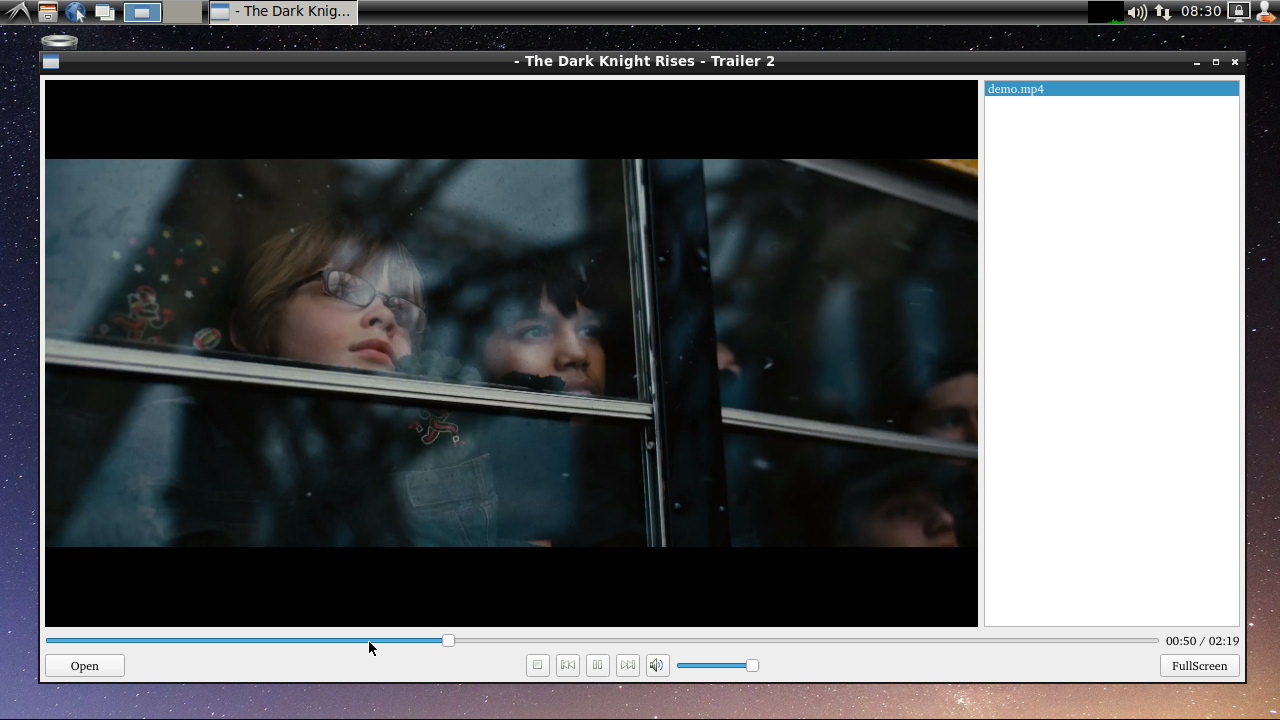
Qt5-VideoPlayer source code: https://github.com/friendlyarm/rk-player-qt
7.7.2 Play with Linux Command
You can play it by running the following command in a commandline utility:
gst-player.sh
By default its voice will be output to audio jack. You can locate this script by commanding "which gst-player.sh". You can customize its behavior by making changes in this script.
7.8 Work with USB Camera
Insert the USB camera (such as Logitech C270/C920) into the development board. Double click the "USB Camera" icon on desktop will pop up the luvcview gui (need to use the 2019/05/11+ version firmware).
the luvcview tool is an open source software that you can compile yourself:
git clone https://github.com/ksv1986/luvcview cd luvcview make
View the usage of luvcview:
./luvcview -h
Parameter Description:
luvcview version 0.2.1 Usage: uvcview [-h -d -g -f -s -i -c -o -C -S -L -l -r] -h print this message -d /dev/videoX use videoX device -g use read method for grab instead mmap -w disable SDL hardware accel. -f video format default jpg others options are yuv jpg -i fps use specified frame interval -s widthxheight use specified input size -c enable raw frame capturing for the first frame -C enable raw frame stream capturing from the start -S enable raw stream capturing from the start -o avifile create avifile, default video.avi -L query valid video formats -l query valid controls and settings -r read and set control settings from luvcview.cfg
To preview USB camera (640x360@30fps), you can use the following command:
./luvcview -d /dev/video8 -i 30 -s 640x360
As you can see from the output of luvcview, hardware acceleration has been turned on:
pi@NanoPC-T4:/etc/xrdp$ luvcview -d /dev/video8 -i 30 -s 640x360 luvcview version 0.2.1 interval: 30 fps Hardware acceleration available video /dev/video8
7.9 File Transfer with Bluetooth
Click on the "Preferences" in the main window's menu to start Bluetooth Manager and click on "Search" to search surrounding Bluetooth devices. Click on your wanted device, pair the device with your board and you will be able to do file transfer, here is how it looks like:
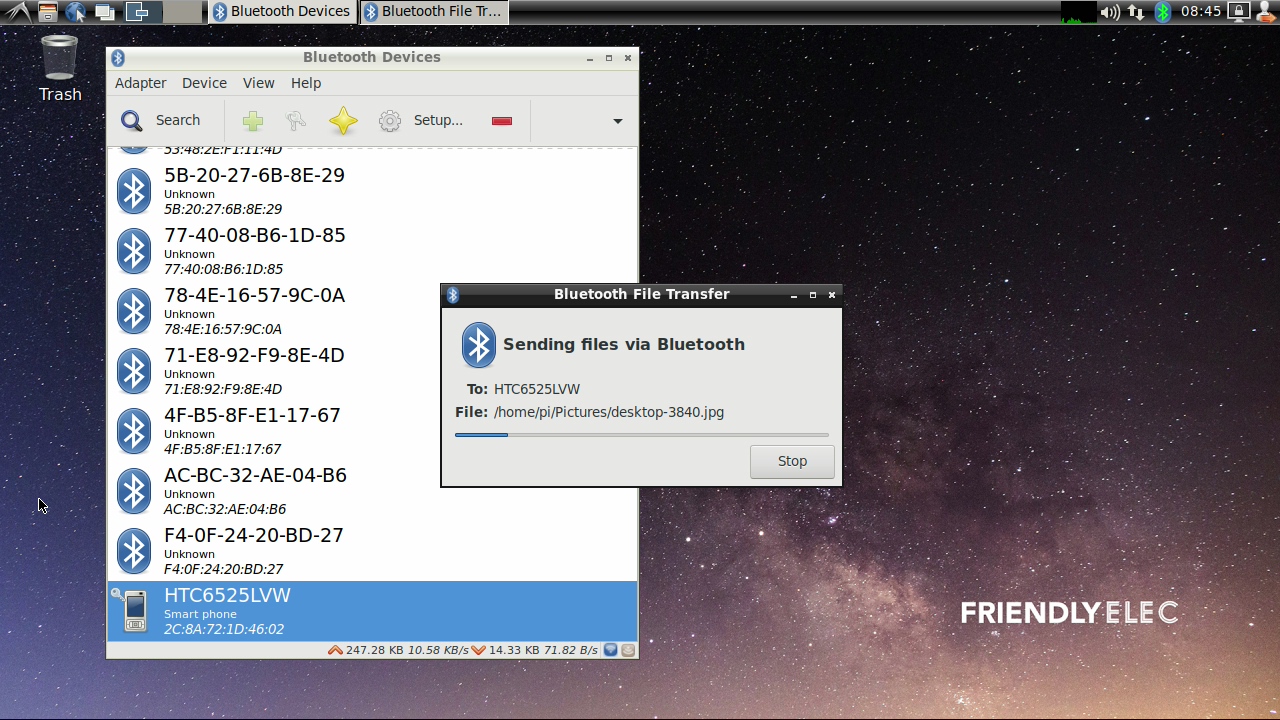
7.10 Install OpenCV
OpenCV has been pre-installed in FriendlyCore/FriendlyDesktop (Version after 201905) and does not require manual installation.
Please refre this link: https://github.com/friendlyarm/install-opencv-on-friendlycore/blob/rk3399/README.md
7.11 Develop Qt Applications
FriendlyDesktop has a Qt 5.10.0 which supports RK3399's OpenGL ES and Gstreamer 1.0 hardware acceleration and a QtCreator IDE which is ready and can be used to compile and run applications. Here is how it looks like:
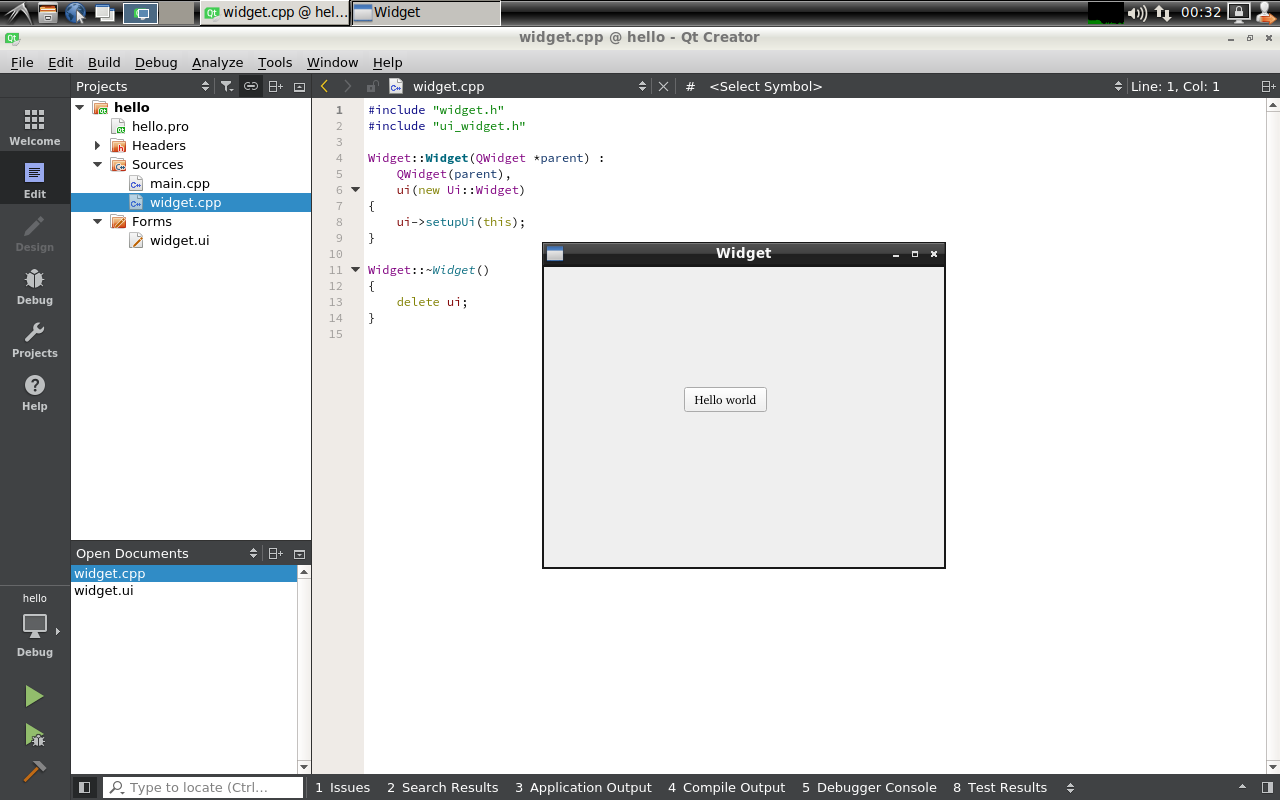
When running the Qt app, you need to specify the platform parameter to xcb as follows:
./HelloQt --platform xcb
7.12 WiringPi and Python Wrapper
7.13 Switch audio default output device
7.13.1 View the current default output device
On the terminal of the non-root user, enter the following command:
pactl info -vvvThe information displayed contains the following, indicating that the current audio output is directed to the headset:
Default Sink: alsa_output.platform-rt5651-sound.stereo-fallback
The information displayed contains the following, indicating that the current audio output is to HDMI:
Default Sink: alsa_output.platform-hdmi-sound.stereo-fallback
7.13.2 Set headphone jack as the default output device
On the terminal of the non-root user, enter the following command:
pactl set-default-sink alsa_output.platform-rt5651-sound.stereo-fallback
Set default volume to 20%:
pactl -- set-sink-volume alsa_output.platform-rt5651-sound.stereo-fallback 20%
7.13.3 Set hdmi as the default output device
On the terminal of the non-root user, enter the following command:
pactl set-default-sink alsa_output.platform-hdmi-sound.stereo-fallback
7.13.4 View settings have taken effect
cat /var/lib/pulse/*-default-sink
7.13.5 Temporary switching during playback
This method is only valid for the current playback process:
Open the menu "Sound & Video" -> "PulseAudio Volume Control", click the "Built-in Audio Stereo" button on the interface to switch between different output devices, such as switching between HDMI and headphone jack.
7.14 Play RTSP video stream (or IP Camera)
Open a command line terminal and enter the following command:
gst-launch-1.0 rtspsrc location="rtsp://admin:12345@192.168.1.120:554/live/main" ! rtph264depay ! decodebin ! rkximagesink
Change the address after rtsp:// to the real address.
7.15 Chromium web browser
Chromium web browser has enabled hardware acceleration by default, supports WebGL, and can view hardware acceleration details by entering the URL chrome://gpu, as shown below:
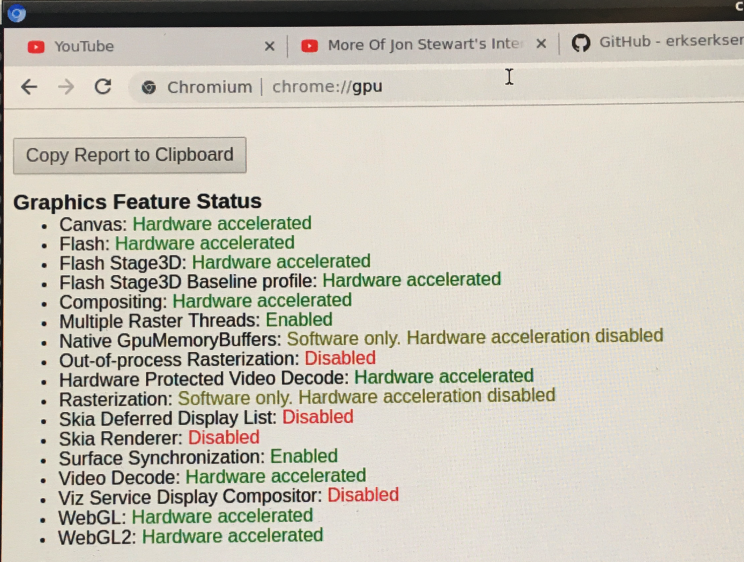
The screen saver configuration file is /etc/xdg/autostart/xset_command.desktop. The default factory settings are that the screen saver and DPMS are both closed. You can change the configuration by modifying this file.
7.17 Install Scratch
enter the following command:
sudo apt-get install scratch:arm64
7.18 Install Arduino IDE
enter the following command:
sudo apt-get install arduino:arm64
7.19 Start the program automatically at startup
Put the desktop file in the ~/.config/autostart/ directory, for example:
cp /usr/share/applications/org.qt-project.qtcreator.desktop ~/.config/autostart/
7.20 Login to the desktop as the root user
Edit the /root/.profile file:
sudo vim /root/.profile
Replace with the following:
if [ -n "$BASH_VERSION" ]; then if [ -f "$HOME/.bashrc" ]; then . "$HOME/.bashrc" fi fi if [ -d "$HOME/bin" ] ; then PATH="$HOME/bin:$PATH" fi
Run the following command to modify the lightdm configuration file and change the automatically logged-in user name to root:
sudo sed -i 's/autologin-user=pi/autologin-user=root/g' /usr/share/lightdm/lightdm.conf.d/20-defaultsession.conf
Run the reboot command to restart:
sudo rebootIf you want to log in, the desktop icons and configuration are the same as the pi user, you can copy the relevant directory from the /home/pi directory:
sudo rm -rf /root/Desktop /root/Pictures /root/.config sudo cp -af /home/pi/Desktop /home/pi/Pictures /home/pi/.config /root/ sudo chown root:root /root/Desktop /root/Pictures /root/.config
7.21 Using NVME SSD on FriendlyDesktop
Please see this article: Linux-Using-NVME-SSD
8 Work with FriendlyCore
8.1 Introduction
FriendlyCore is a Ubuntu core based OS which doesn't have X Desktop. Its current version is 18.04
FriendlyCore targets enterprise users and is customized for industrial applications. FriendlyCore and Ubuntu base target different users. FriendlyCore has both a commandline utility and a two GUI utilities:
1)Qt 5.10.0 cuustomized for ROCKCHIP3399. It supports GPU and VPU acceleration and has modules like: QtQuick/QtWebEngine/QtMultimedia/WebGL and three display plug-ins:KMS, EGLFS and XCB;
2) Xorg system. It can run X11 applications and supports hardware acceleration;
FriendlyCore for RK3399 has the following features:
- supports FriendlyElec's 7"LCD with capacitive touch - HD702. If a board is connected to both an LCD and an HDMI monitor the LCD and the HDMI monitor can be set to display either differently or the same;
- supports Gstreamer 1.0 multi-media framework;
- supports hard encoding video playing with either commandline utility or Qt player;
- supports Qt5 WebGL;
- supports Qt5 VNC and runs a Qt application as a VNC Server allowing remote control;
- supports bluetooth. It has preinstalled bluez packages;
8.2 System Login
- If your board is connected to an HDMI monitor you need to use a USB mouse and keyboard.
- If you want to do kernel development you need to use a serial communication board, ie a PSU-ONECOM board, which will
You can use a USB to Serial on SOM-RK3399: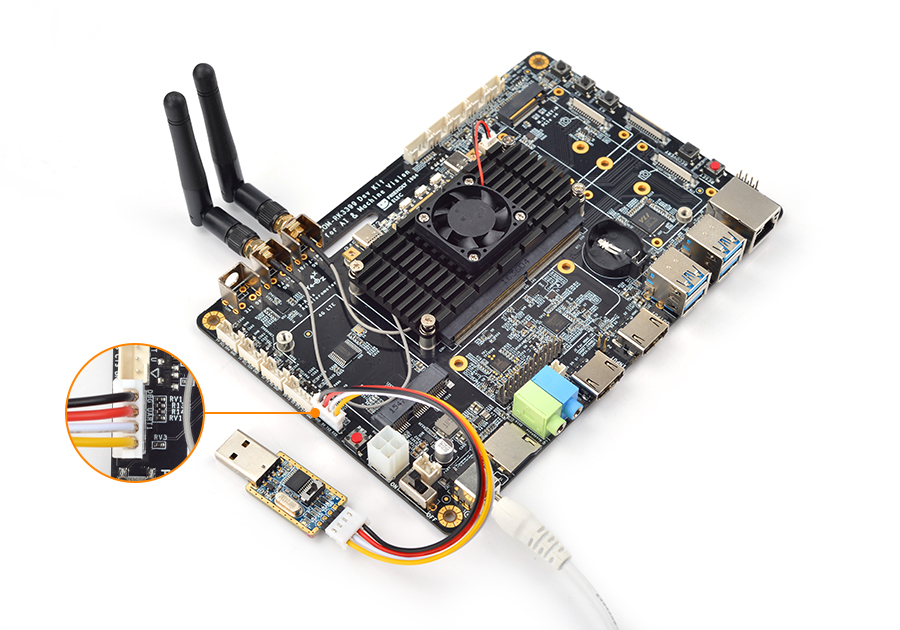
- FriendlyCore User Accounts:
Non-root User:
User Name: pi Password: pi
Root:
User Name: root Password: fa
The system is automatically logged in as "pi". You can do "sudo npi-config" to disable auto login.
- Update packages
$ sudo apt-get update
8.3 Configure System with npi-config
The npi-config is a commandline utility which can be used to initialize system configurations such as user password, system language, time zone, Hostname, SSH switch , Auto login and etc. Type the following command to run this utility.
$ sudo npi-config
Here is how npi-config's GUI looks like:

8.4 Develop Qt Application
Please refer to: How to Build and Install Qt Application for FriendlyELEC Boards
8.5 Setup Program to AutoRun
You can setup a program to autorun on system boot with npi-config:
sudo npi-configGo to Boot Options -> Autologin -> Qt/Embedded, select Enable and reboot.
8.6 Extend TF Card's Section
When FriendlyCore is loaded the TF card's section will be automatically extended.You can check the section's size by running the following command:
$ df -h
8.7 Transfer files using Bluetooth
Take the example of transferring files to the mobile phone. First, set your mobile phone Bluetooth to detectable status, then execute the following command to start Bluetooth search.:
hcitool scan
Search results look like:
Scanning ...
2C:8A:72:1D:46:02 HTC6525LVWThis means that a mobile phone named HTC6525LVW is searched. We write down the MAC address in front of the phone name, and then use the sdptool command to view the Bluetooth service supported by the phone:
sdptool browser 2C:8A:72:1D:46:02
Note: Please replace the MAC address in the above command with the actual Bluetooth MAC address of the mobile phone.
This command will detail the protocols supported by Bluetooth for mobile phones. What we need to care about is a file transfer service called OBEX Object Push. Take the HTC6525LVW mobile phone as an example. The results are as follows:
Service Name: OBEX Object Push Service RecHandle: 0x1000b Service Class ID List: "OBEX Object Push" (0x1105) Protocol Descriptor List: "L2CAP" (0x0100) "RFCOMM" (0x0003) Channel: 12 "OBEX" (0x0008) Profile Descriptor List: "OBEX Object Push" (0x1105) Version: 0x0100
As can be seen from the above information, the channel used by the OBEX Object Push service of this mobile phone is 12, we need to pass it to the obexftp command, and finally the command to initiate the file transfer request is as follows:
obexftp --nopath --noconn --uuid none --bluetooth -b 2C:8A:72:1D:46:02 -B 12 -put example.jpg
Note: Please replace the MAC address, channel and file name in the above command with the actual one.
After executing the above commands, please pay attention to the screen of the mobile phone. The mobile phone will pop up a prompt for pairing and receiving files. After confirming, the file transfer will start.
Bluetooth FAQ:
1) Bluetooth device not found on the development board, try to open Bluetooth with the following command:
rfkill unblock 02) Prompt can not find the relevant command, you can try to install related software with the following command:
apt-get install bluetooth bluez obexftp openobex-apps python-gobject ussp-push8.8 WiFi
For either an SD WiFi or a USB WiFi you can connect it to your board in the same way. The APXX series WiFi chips are SD WiFi chips. By default FriendlyElec's system supports most popular USB WiFi modules. Here is a list of the USB WiFi modules we tested:
Index Model 1 RTL8188CUS/8188EU 802.11n WLAN Adapter 2 RT2070 Wireless Adapter 3 RT2870/RT3070 Wireless Adapter 4 RTL8192CU Wireless Adapter 5 mi WiFi mt7601 6 5G USB WiFi RTL8821CU 7 5G USB WiFi RTL8812AU
You can use the NetworkManager utility to manage network. You can run "nmcli" in the commandline utility to start it. Here are the commands to start a WiFi connection:
- Change to root
$ su root
- Check device list
$ nmcli devNote: if the status of a device is "unmanaged" it means that device cannot be accessed by NetworkManager. To make it accessed you need to clear the settings under "/etc/network/interfaces" and reboot your system.
- Start WiFi
$ nmcli r wifi on- Scan Surrounding WiFi Sources
$ nmcli dev wifi- Connect to a WiFi Source
$ nmcli dev wifi connect "SSID" password "PASSWORD" ifname wlan0
The "SSID" and "PASSWORD" need to be replaced with your actual SSID and password.If you have multiple WiFi devices you need to specify the one you want to connect to a WiFi source with iface
If a connection succeeds it will be automatically setup on next system reboot.
For more details about NetworkManager refer to this link: Use NetworkManager to configure network settings
If your USB WiFi module doesn't work most likely your system doesn't have its driver. For a Debian system you can get a driver from Debian-WiFi and install it on your system. For a Ubuntu system you can install a driver by running the following commands:
$ apt-get install linux-firmware
In general all WiFi drivers are located at the "/lib/firmware" directory.
8.9 Ethernet Connection
If a board is connected to a network via Ethernet before it is powered on it will automatically obtain an IP with DHCP activated after it is powered up. If you want to set up a static IP refer to: Use NetworkManager to configure network settings。
8.10 Custom welcome message
The welcome message is printed from the script in this directory:
/etc/update-motd.d/
For example, to change the FriendlyELEC LOGO, you can change the file /etc/update-motd.d/10-header. For example, to change the LOGO to HELLO, you can change the following line:
TERM=linux toilet -f standard -F metal $BOARD_VENDOR
To:
TERM=linux toilet -f standard -F metal HELLO
8.11 Modify timezone
For exampe, change to Shanghai timezone:
sudo rm /etc/localtime sudo ln -ls /usr/share/zoneinfo/Asia/Shanghai /etc/localtime
8.12 Select the system default audio device
You can set the system default audio device by following the steps below.
Use the following command to view all the sound card devices in the system (Note: different development boards will have different results):
pi@NanoPi:~$ aplay -l **** List of PLAYBACK Hardware Devices **** card 0: realtekrt5651co [realtek,rt5651-codec], device 0: ff880000.i2s-rt5651-aif1 rt5651-aif1-0 [] Subdevices: 1/1 Subdevice #0: subdevice #0 card 1: rockchiphdmi [rockchip,hdmi], device 0: ff8a0000.i2s-i2s-hifi i2s-hifi-0 [] Subdevices: 1/1 Subdevice #0: subdevice #0 card 2: ROCKCHIPSPDIF [ROCKCHIP,SPDIF], device 0: ff870000.spdif-dit-hifi dit-hifi-0 [] Subdevices: 1/1 Subdevice #0: subdevice #0
As you can see, the following sound card devices are available on the hardware:
Sound card device Sound card number Description realtekrt5651co 0 Realtek sound card's default output interface (through 3.5mm jack interface) rockchiphdmi 1 HDMI ROCKCHIPSPDIF 2 SPDIF (Note: temporarily unavailable, because the hardware is not exported)...
To configure the audio output to the 3.5mm jack, modify the configuration file /etc/asound.conf and modify it to the following:
defaults.pcm.card 0 defaults.pcm.device 0
To configure to output audio to HDMI, change the defaults.pcm.card above to 1.
Note that some boards do not have a Realtek sound card (no 3.5mm jack interface), so the card number of the HDMI device will be 0, so the configuration should be based on the result of the aplay -l command.
8.13 Change the behavior of the PWM fan
By default, the speed of the fan is dynamically adjusted according to the CPU temperature. If you need to let the fan run, you can modify the script /usr/bin/start-rk3399-pwm-fan.sh to the following:
#!/bin/bash echo 0 > /sys/class/pwm/pwmchip1/export sleep 1 echo 0 > /sys/class/pwm/pwmchip1/pwm0/enable echo 50000 > /sys/class/pwm/pwmchip1/pwm0/period echo 1 > /sys/class/pwm/pwmchip1/pwm0/enable echo 45000 > /sys/class/pwm/pwmchip1/pwm0/duty_cycle
8.14 Run the X11 application
FriendlyCore system built-in lightweight Xorg,although there is no window manager, you can still run a single X-Windows application,For example, the program to run is ~/YourX11App,use the following command:
. /usr/bin/setqt5env-xcb startx ~/YourX11App -geometry 1280x800
Note that there is a space between "." and /usr/bin/setqt5env-xcb. In addition, the resolution after -geometry should be changed to the actual resolution of your screen.
8.15 Mpv hardware decoding video player
FriendlyCore comes pre-installed with the ffmpeg-based command line video player mpv, which also includes libmpv.
The mpv player supports Rockchip MPP video decoder, so it supports 4K hardware decoding. There are many parameters of mpv. In order to simplify the use, we provide a script start-mpv. After simplification, there is only one parameter: video file name, as follows:
start-mpv /home/pi/demo.mp4
It should be noted that the pi user needs to log in during playback, because there are no mpv related settings in other users' directories. Of course, you can copy one from the pi user directory. The mpv settings file is stored in the following path:
/home/pi/.config/mpv/mpv.conf
The contents of the mpv.conf file are as follows:
vo=gpu gpu-context=drm hwdec=rkmpp demuxer-max-bytes=41943040 demuxer-max-back-bytes=41943040 drm-osd-plane-id=1 drm-video-plane-id=0 audio-device=alsa/default:CARD=rockchiphdmi
These will be passed as parameters to mpv. When the value of hwdec is rkmpp, it means using hardware decoding, audio-device is used to specify the audio output device, and the default output is to HDMI. You can use the following command to query which audio devices are in the system:
mpv --audio-device=help
Another important parameter is drm-osd-size. When playing video in full screen, drm-osd-size is specified as the resolution of the screen. This parameter is automatically obtained by start-mpv and passed to mpv, start-mpv script will do one more important thing. It needs to ensure that the libmali library in the system uses the correct version, because mpv renders the image through gbm, so libmali.so needs to use this version: libmali-midgard-t86x -r14p0-gbm.so, which means that this version of mpv can only be used under FriendlyCore, can not be used under X11 Desktop.
Mpv official use guide:https://github.com/mpv-player/mpv/wiki
9 Features applicable to FriendlyDesktop and FriendlyCore
9.1 Using Camera on Linux (MIPI Camera OV13850 & OV4689, and webcam logitect C920)
Hardware Setting:
The Camera module can be connected to a MIPI port:
FriendlyELEC provides some scripts use to test a camera's functions. You can run it in a commandline to test picture taking and video recording.
You may try update this script to the lastest version by using the following commands:
cd /tmp/ git clone https://github.com/friendlyarm/gst-camera-sh.git sudo cp gst-camera-sh/*.sh /usr/bin/
There are three scripts:
gst-camera.sh: preview, photo and video of a single camera
dual-camera.sh: preview two cameras
stop-gst-camera.sh: stop preview
9.1.1 Options in "gst-camera.sh"
Options Comment --index or -i Camera's index, it can be either 0 or 1. When two cameras are connected to a board you need to specify 1 to access the second camera. --action or -a Specify an action, it can be "preview" to preview, "photo" to take a picture or "video" to record video --output or -o Specify an output file to save a picture when taking a picture or video file when recording video --verbose or -v If it is specified as "yes" it will output the complete command when "gst-launch-1.0" is called -x Using the rkximagesink plugin, the preview image will be output to the X11 window for the FriendlyDesktop and Lubuntu systems -g Using the glimagesink plugin, the preview image will be output to the X11 window for the FriendlyDesktop and Lubuntu systems -k Using the kmssink plugin, the preview image will be output directly to the screen for the FriendlyCore system
The script gst-camera.sh will automatically recognize OV13850, OV4689 and C920 camera, and then pass the appropriate parameters to gst-launch-1.0.
9.1.2 Usage of gst-camera.sh
- Preview
gst-camera.sh --action preview- Picture Taking
You can run the following command to take a picture and save it as a "1.jpg" file,
gst-camera.sh -a photo -o 1.jpg
- Preview and Record
You can run the following command to record video and save your video to a "1.ts" file. Hardware encoding is activated when it is recording video.
gst-camera.sh --action video -output 1.ts
- Show Complete Command
If you add the "--verbose yes" option it will show a complete gsteamer command.
gst-camera.sh --action video --output 1.ts --verbose yes
Here is the complete gsteamer command you will see:
gst-launch-1.0 rkisp num-buffers=512 device=/dev/video0 io-mode=1 ! \ video/x-raw,format=NV12,width=1280,height=720,framerate=30/1 ! \ mpph264enc ! queue ! h264parse ! mpegtsmux ! \ filesink location=/tmp/camera-record.ts
- Preview dual camera
Connect two mipi cameras, or one mipi camera and one usb camera (tested only: Logitech C920 pro), call the following command:
dual-camera.sh
Note: It is recommended to test this on FriendlyDesktop.
9.1.3 gst-launch-1.0 parameter description
Preview camera on FriendlyDesktop:
gst-launch-1.0 rkisp device=/dev/video1 io-mode=4 ! video/x-raw,format=NV12,width=1280,height=720,framerate=30/1 ! rkximagesink
Important parameters
parameter description device preview device(selfpath): /dev/video1 and /dev/video5, picture device(mainpath): /dev/video0 and /dev/video4, webcam device: /dev/video8 io-mode 1: memory map, 4:dmabuf rkximagesink/glimagesink/kmssink rkximagesink for FriendlyDesktop, kmssink for FriendlyCore, glimagesink for webcam on FriendlyDesktop
9.1.4 Access the camera in OpenCV
MIPI camera:
cv.VideoCapture('rkisp device=/dev/video1 io-mode=4 ! video/x-raw,format=NV12,width=640,height=480,framerate=30/1 ! videoconvert ! appsink', cv.CAP_GSTREAMER)
USB camera:
cv.VideoCapture('rkisp device=/dev/video8 io-mode=4 ! videoconvert ! video/x-raw,format=NV12,width=640,height=480,framerate=30/1 ! videoconvert ! appsink', cv.CAP_GSTREAMER)
Please refer to the sample code here for details:https://github.com/friendlyarm/install-opencv-on-friendlycore/tree/rk3399/examples
9.1.5 Camera application tutorial: Push video stream
Please refre this guide: How to setup RTMP server on NanoPC-T4
9.1.6 Reference resource
http://blog.iotwrt.com/media/2017/10/01/camera/ http://www.360doc.com/content/16/1019/17/496343_599664458.shtml
9.2 How to install and use docker
9.2.1 How to Install Docker
Run the following commands:
wget https://download.docker.com/linux/ubuntu/dists/bionic/pool/stable/arm64/containerd.io_1.2.6-3_arm64.deb wget https://download.docker.com/linux/ubuntu/dists/bionic/pool/stable/arm64/docker-ce-cli_19.03.2~3-0~ubuntu-bionic_arm64.deb wget https://download.docker.com/linux/ubuntu/dists/bionic/pool/stable/arm64/docker-ce_19.03.2~3-0~ubuntu-bionic_arm64.deb sudo dpkg -i containerd.io_1.2.6-3_arm64.deb sudo dpkg -i docker-ce-cli_19.03.2~3-0~ubuntu-bionic_arm64.deb sudo dpkg -i docker-ce_19.03.2~3-0~ubuntu-bionic_arm64.deb
9.2.2 Test Docker installation
Test that your installation works by running the simple docker image:
git clone https://github.com/friendlyarm/debian-jessie-arm-docker cd debian-jessie-arm-docker ./rebuild-image.sh ./run.sh
9.3 Using ffmpeg (video hardware decoding)
Both FriendlyCore and FriendlyDesktop systems are built-in ffmpeg, with bin file, static libraries, and header files, all stored in the /usr/ffmpeg-rkmp directory.
ffmpeg supports the RockChip MPP video decoder, for details, please refer to: https://trac.ffmpeg.org/wiki/HWAccelIntro
Test the decoding performance of 4K video:
/usr/ffmpeg-rkmp/bin/ffmpeg -benchmark -loglevel 48 -vcodec h264_rkmpp -i 4K-Chimei-inn-60mbps.mp4 -map 0:v:0 -f null -
The results are shown below:
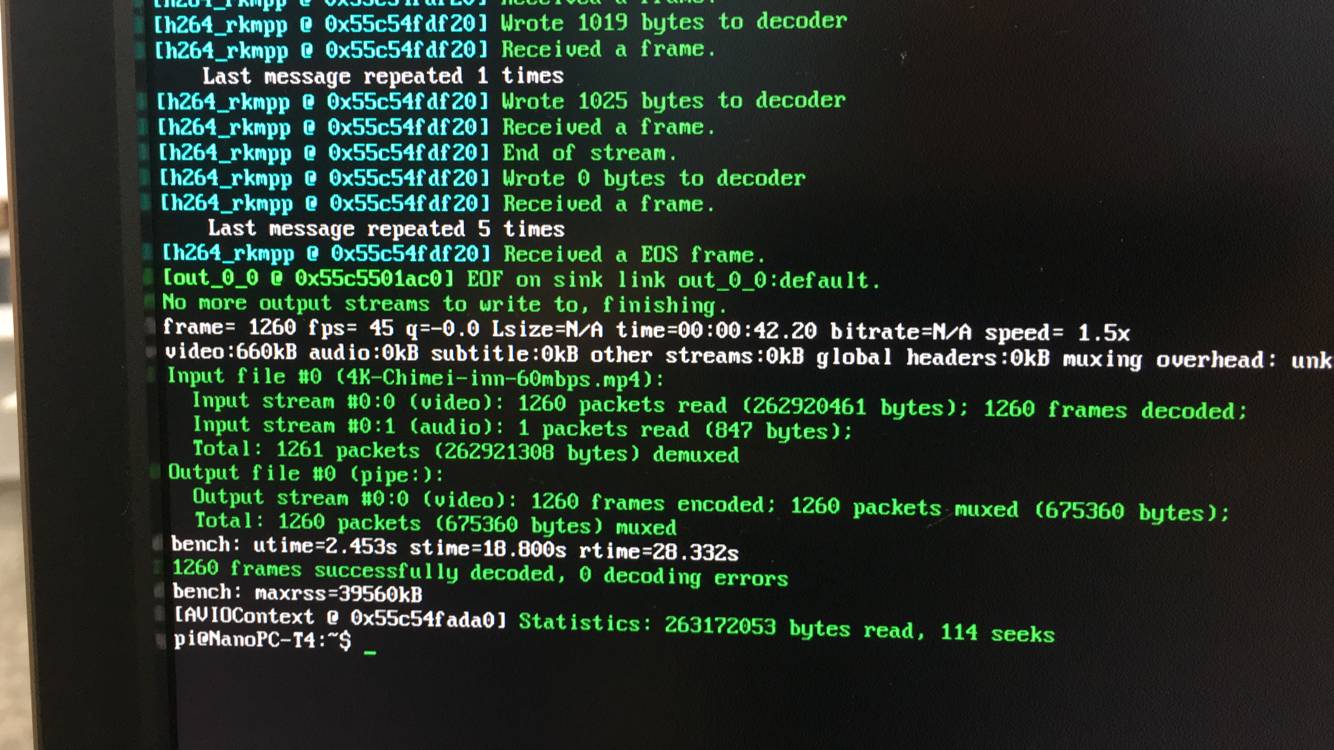
To play the video, you can use the ffmpeg-based player mpv. The 4K video used for the above test can be found in the test-video directory of the network disk. The network address is http://dl.friendlyelec.com/nanopct4.
10 Connect NVME SSD High Speed Hard Disk
10.1 Detection of SSD
root@FriendlyELEC:~# cat /proc/partitions major minor #blocks name 1 0 4096 ram0 259 0 125034840 nvme0n1
If there is a nvme0n1 device node it means an SSD is recognized.
10.2 Partition of SSD
To mount an SSD under Linux we re-partition it as one section by running the following command:
(echo g; echo n; echo p; echo 1; echo ""; echo ""; echo w; echo q) | fdisk /dev/nvme0n1
If you want to re-partition it to multiple sections you can run "fdisk /dev/nvme0n1". For more detail about this command refer to the fdisk's manual.
10.3 Format Section to EXT4
After an SSD is successfully partitioned you can check its sections by running "cat /proc/partitions". The /dev/nvme0n1p1 section is used to store data:
root@FriendlyELEC:~# cat /proc/partitions major minor #blocks name 1 0 4096 ram0 259 0 125034840 nvme0n1 259 2 125033816 nvme0n1p1
The following command formats a section to ext4:
mkfs.ext4 /dev/nvme0n1p1
10.4 Auto Mount SSD on System Startup
Before we mount an SSD's section you need to know its Block ID. You can check it by running "blkid":
blkid /dev/nvme0n1p1 /dev/nvme0n1p1: UUID="d15c4bbf-a6c3-486f-8f81-35a8dbd46057" TYPE="ext4" PARTUUID="887628f0-01"
Add a "Block ID" to "/etc/fstab" and here is what it looks like
UUID=<Block ID> /media/nvme ext4 defaults 0 0
You need to replace <Block ID> with the UUID obtained by running "blkid". To mount the SSD in our example we made the "/etc/fstab" file as follows:
UUID=d15c4bbf-a6c3-486f-8f81-35a8dbd46057 /media/nvme ext4 defaults 0 0
We want to mount an SSD to "/media/nvme" but this directory doesn't exist. Therefore we create it and change its access right by running the following commands:
mkdir -p /media/nvme chmod 777 /media/nvme
Run "mount" to check if the SSD is mounted successfully:
mount /media/nvme
You can reboot your board to check if your SSD will be automatically mounted:
reboot
10.5 Fan speed setting
The fan uses PWM to automatically adjust the speed. It determines the fan switch and the fan speed according to the current CPU temperature. If the current CPU temperature is not high, the fan will be turned off or rotated at a lower speed (reducing unnecessary environmental noise). ),
If you want the fan to start working immediately, you can use the following command to get the CPU running at high load immediately. This is one way to test if the fan works:
cpuburn
if you want to change the speed regulation behavior of the fan, please modify the following file:
/usr/bin/fa-fancontrol.sh # Entry, called by the pwm-fan.service service to control the fan in two ways, either by the kernel or by the user space by control the PWM. /usr/bin/fa-fancontrol-direct.sh # Script to control the fan from user space by control the PWM to control the fan speed, etc. This script is called from the above script.
Need to cancel the boot automatically start the fan (such as you need to connect the other PWM device), please enter the following command:
systemctl stop pwm-fan systemctl disable pwm-fan
Or delete the two files below:
/etc/systemd/system/pwm-fan.service /etc/systemd/system/multi-user.target.wants/pwm-fan.service
10.6 Using 4G Module EC20 on Linux
Please see this article: How to use 4G Module on SOM-RK3399
11 Buildroot Linux
Buildroot is a simple, efficient and easy-to-use tool to generate embedded Linux systems through cross-compilation. It contains a boot-loader, kernel, rootfs, various libraries and utilities(e.g. qt, gstreamer, busybox etc).
FriendlyELEC's Buildroot is based on Rockchip's version which is made with linux-sdk and maintained with git. FriendlyELEC's version is synced with Rockchip's version;
- Rockchip's Buildroot: https://github.com/rockchip-linux/buildroot
- Buildroot's official site: https://buildroot.org
Here is what Buildroot for rockchip looks like
For a more detailed description of the Buildroot system, please refer to: Buildroot
12 Work with Lubuntu
See here: Lubuntu desktop 16.04 for RK3399
Using NVME SSD on Lubuntu: Linux-Using-NVME-SSD
13 Work with Android 8.1
FriendlyElec provides a full Android8.1 BSP for SOM-RK3399. The source code is hosted at gitlab.com and is open source. The BSP supports GPU and VPU hardware acceleration.
13.1 Connect MIPI Camera to SOM-RK3399
FriendlyElec developed a MIPI camera CAM1320 for board and it works under Android. You can use this camera to take pictures and record video. The operation is straightforward. You just need to connect the camera at your board's MIPI interface, boot your board to Android and start Android's camera app.
13.2 Use dual MIPI camera preview and video
Download the sample source code below from github and compile and run it:
git clone https://github.com/friendlyarm/Dual-Camera.git -b working-branch
After the application is installed, you need to Set Android permissions to make the demo run normally. The method is enter system ui: Settings -> Apps & notifications -> Dual Camera -> Permissions, Select the following permissions:
Camera Microphone Storage
The gui looks like this:
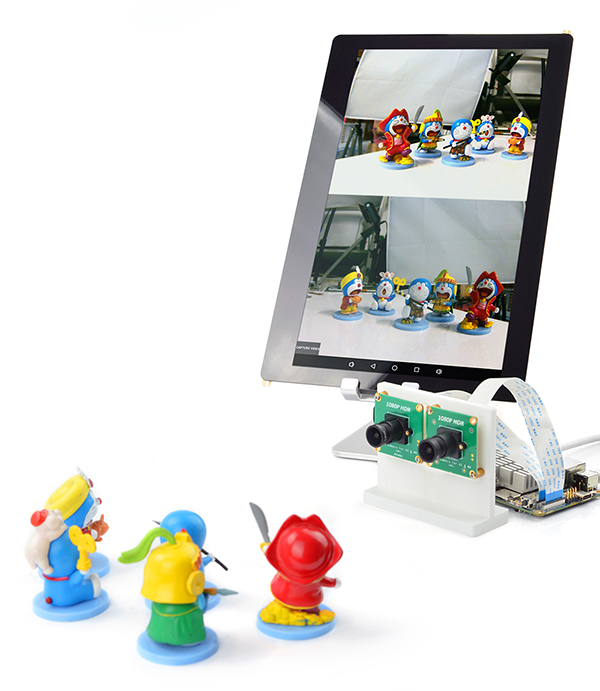
Click the "CAPTURE VIDEO" button on the gui to record the video (two cameras at the same time), and the video file will be saved to the following location.:/storage/emulated/0/Download/dualcamera_h264.mp4.
Known issue:
Recorded video file will play faster than normal, may need to adjust some parameters of mediacodec.
13.3 Change system language
The default system language of Android system is English. For example, if we want to set it to Chinese, the steps are as follows:
1) Go to Android settings:Settings -> System -> Languages & Input -> Languages;
2)Click "Add a language", Select "简体中文", and then select "中国";
3) At this time, there will be two languages, Chinese and English. Drag the Chinese item to the top of the list. Note that if you are using a mouse, drag it by placing the mouse pointer on the right side of the list item. On the icon and then press the middle mouse button to drag;
13.4 Android8.1 hardware access
You can use the FriendlyThings SDK to access and control hardware resources on the motherboard in the Android App, such as Uart, SPI, I2C, GPIO and other interfaces. For details, please refer to the following two documents.:
13.5 Android Neural Networks SDK Sample
Android8.1 BSP comes pre-installed with Rockchip's Android NN SDK for Android 8.1, supporting GPU acceleration.。
Sample program for Android NN pre-installed in the Android8 firmware we provide:TfLiteCameraDemo,This is a MobileNet classifier demo using Rockchip AndroidNN GPU acceleration,The camera module is required to be connected to the motherboard during operation. The USB camera and CSI camera are supported,The sample program is launched by clicking the "TfLiteCameraDemo" icon on the home page. The running effect is as follows:
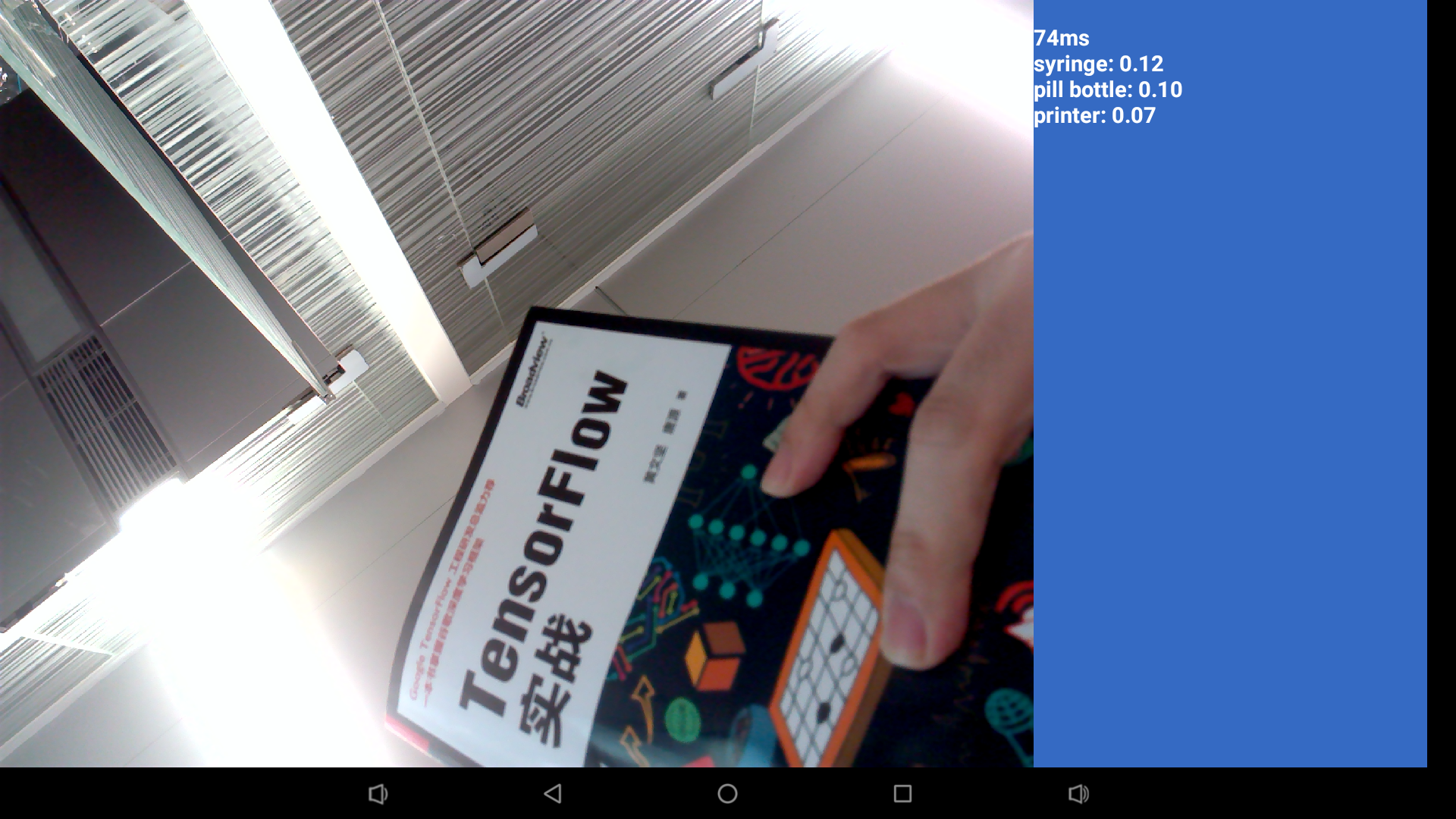
For a detailed description of the Android NN SDK, you can refer to this document:[RK3399_Android8.1_AndroidNN_SDK_V1.0_20180605发布说明.pdf]
TfLiteCameraDemo sample source code download link:[TfLiteCameraDemo source code]
13.6 Using the adb
1. The first time you start the system, if you need to change the system files, you need to turn off security verification (note: apk installation does not need to be closed), and restart after turning off security verification
adb root adb disable-verity adb reboot
2. After restarting, get root and remount /system to enable write permissions
adb root adb remount
3. Upload a file
adb push example.txt /system/
13.7 HDMI resolution and overscan setting
If an HDMI display device is connected, go to Android Settings -> Display -> Advanced -> HDMI & Rotation to set it up.
HDMI Resolution The default is Auto, you can manually set the display resolution, up to 4K resolution Screen Zoom click the four arrow buttons in the middle to adjust the zoom Display Rotation for horizontal and vertical screen switching
13.8 Screen rotation
go to Android Settings -> Display -> Advanced -> HDMI & Rotation to set it up.
Use the following command in shell to test screen rotation (Settings not saved):
wm rotation 90Enter Settings -> Accessibility, Turn on immersive mode, and then open an Android application, For example: Lightning, it will be in full screen mode.
13.10 Switch audio output channel
You can configure the audio output to the HDMI or headphone jack, Setting interface entry method: Android Settings -> Accessibility -> Force audio output. If the Force audio output menu item is gray, that is, it is in an unselectable state, the hardware you are using will automatically detect the headphone plug-in status and automatically switch the audio channel without setting.
13.11 Adjust the volume of the recording
1) First use the amix command to adjust the volume of the recording through the serial port or the adb shell with root privileges, for example:
Amix "IN2 Boost" Amix "ADC Capture Volume"
The above command is used to view the current settings.
2) After debugging, modify the value of the corresponding configuration item in the rt5651_main_mic_capture_controls array in the hardware/rockchip/audio/tinyalsa_hal/codec_config/rt5651_config.h file, compile the Android source code and test it.
13.12 Custom logo and boot animation
13.12.1 On/Off
Change:
BOOT_SHUTDOWN_ANIMATION_RINGING := false
to:
BOOT_SHUTDOWN_ANIMATION_RINGING := true
in device/rockchip/common/BoardConfig.mk file.
13.12.2 Boot animation
Create or replace the following files in the Android source code directory:
kernel/logo.bmp
kernel/logo_kernel.bmp
device/rockchip/common/bootshutdown/bootanimation.zip
13.12.3 Shutdown animation
Create or replace the following files in the Android source code directory:
device/rockchip/common/bootshutdown/shutdownanimation.zip
13.12.4 How to make animation
Please refre to:http://blog.sina.com.cn/s/blog_4960586c0100vu5v.html
13.13 Remove Google Framework
If you don't need to use the google service, you can delete the Google framework to save system resources by deleting the following directory in the Android source code and recompiling Android:
vendor/google
The SOM-RK3399 supports the FriendlyARM RC-100 remote control under Android. To get a better experience your can connect your T4 to an HDMI monitor and navigate Android.
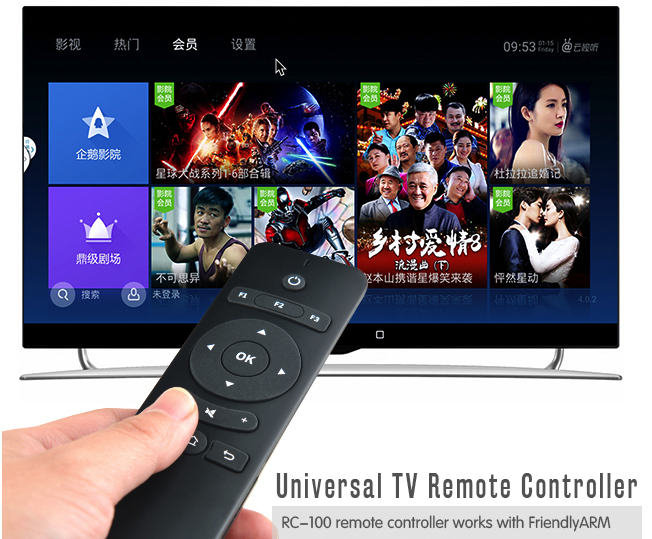
Here is a table for the remote control's keys and corresponding functions:
Key Function Up Navigate - Up Down Navigate - Down Left Navigate - Left Right Navigate - Right OK Confirm - Volume - + Volume + Mute Mute Menu Android Menu Home Android Home Return Android Return F1 Pull-Down Android Message Bar F2 Android Screenshot F3 Switch between mouse and key
13.15 Work with USB Camera to Take Pictures and Record Video
FriendlyELEC's Android system supports picture taking and video recording with a USB camera, Android's camera app has these functions. When you use the app to take pictures or record video you need to be aware of the following two things:
1) Make sure your camera's resolution works. We suggest you try a camera with a lower CIF resolution first. If it works you may switch to a camera with a higher resolution:
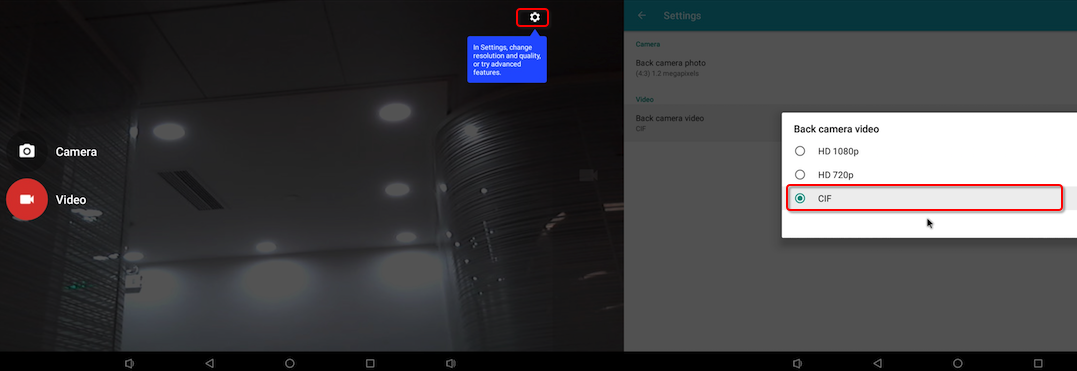 ;
;
2)A USB camera cannot work simultaneously with a MIPI camera. Plug and play is not supporter for camera modules. After you connect a camera to a board you need to reboot your board to enable the camera.
Here are the camera modules we tested: Logitech C270 and LogitechC922 PRO
In our test the resolution was 1080P when we used a Logitech C922 PRO to take pictures or record video.
13.16 Using 4G Module EC20 on Android
13.16.1 Hardware Setup
Connect an EC20 module to a USB to miniPCIe board and connect the board to an ARM board's USB Host. Here is a hardware setup:
Power on the board and you will be able to surf the internet with the 4G module like using an Android phone.
13.16.2 Activate EC20's GPS Functions
By default GPS functions are disabled in Android. If GPS functions are enabled in Android but no GPS module is detected Android will continuously output log messages. After an EC20 module is connected you can enable GPS functions.
To enable the GPS functions open the "vendor/quectel/ec20/BoardConfigPartial.mk" file and change the following line:
BOARD_HAS_GPS := falseto
BOARD_HAS_GPS := trueand recompile Android。
13.17 Using SSD on Android
13.17.1 Step1: Format SSD as ext4
These steps need to be operated under the LINUX system.
For the convenience of operation, please switch to the root user with the following command on the terminal:
su -The default password for the root user is fa.
13.17.1.1 Detection of SSD
root@FriendlyELEC:~# cat /proc/partitions major minor #blocks name 1 0 4096 ram0 259 0 125034840 nvme0n1
If there is a nvme0n1 device node it means an SSD is recognized.
13.17.1.2 Partition of SSD
To mount an SSD under Linux we re-partition it as one section by running the following command:
(echo o; echo n; echo p; echo 1; echo ""; echo ""; echo w; echo q) | fdisk /dev/nvme0n1
If you want to re-partition it to multiple sections you can run "fdisk /dev/nvme0n1". For more detail about this command refer to the fdisk's manual.
13.17.1.3 Format partition to EXT4
After an SSD is successfully partitioned you can check its partitions by running "cat /proc/partitions". The /dev/nvme0n1p1 partition is used to store data:
root@FriendlyELEC:~# cat /proc/partitions major minor #blocks name 1 0 4096 ram0 259 0 125034840 nvme0n1 259 2 125033816 nvme0n1p1
The following command formats a section to ext4:
mkfs.ext4 /dev/nvme0n1p1 -L SSD
13.17.2 Step2: Auto Mount SSD on Android System Startup
Android will automatically mount the SSD as an external storage device. No additional settings are required. Open the built-in Files application of Android and you can see that the SSD device is mounted:
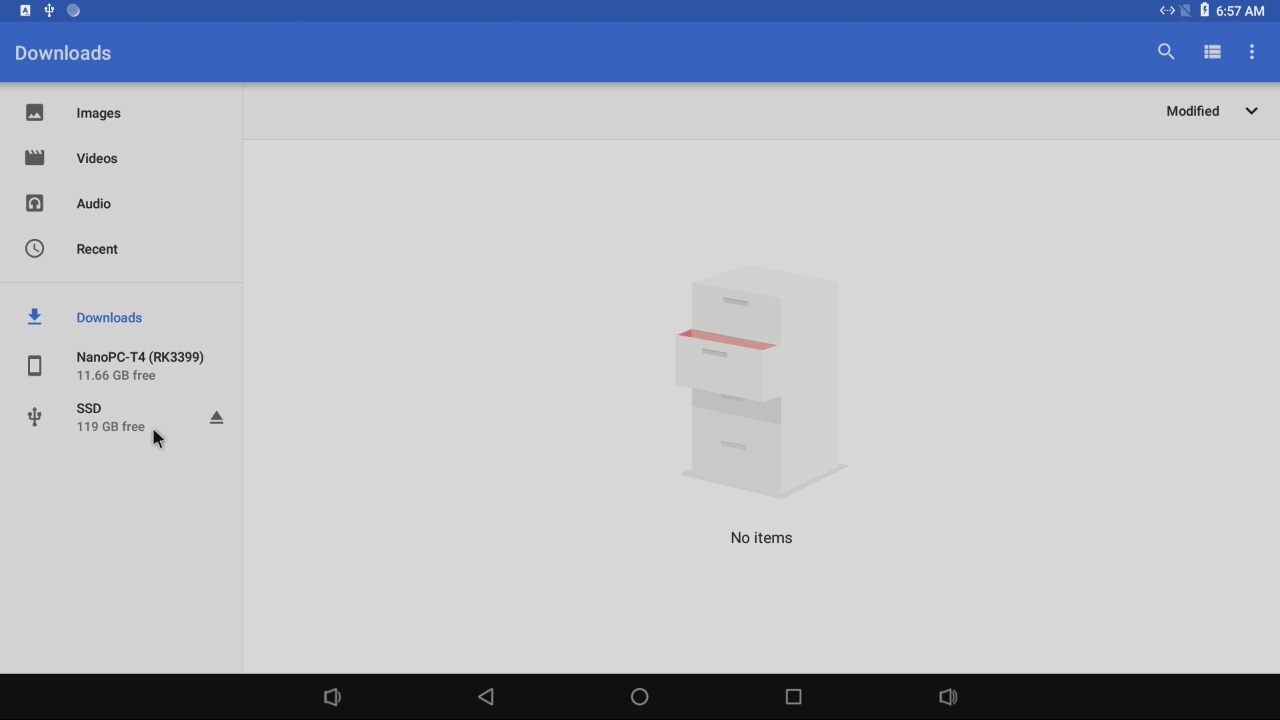
third-party software can recognize SSDs normally.
13.18 Fan speed setting
The fan uses PWM to achieve automatic speed regulation. It determines the fan switch and the fan speed according to the current CPU temperature. If the current CPU temperature is not high, the fan will be turned off or rotated at a lower speed (reducing unnecessary environment). Noise), if you want to change the fan's speed behavior, please modify the following files in the Android bsp source code:
device/rockchip/rk3399/nanopc-t4/pwm_fan.sh
Need to cancel the boot automatically start the fan (such as you need to connect other PWM devices), please modify the following files in the Android bsp source code:
device/rockchip/rk3399/init.rk3399.rc
After modifying the source code, you need to recompile Android.
14 Work with Android7.1
See here: Android7
15 Make Your Own OS Image
15.1 Setup Development Environment
We suggest you do it on a 64 bit Ubuntu 18.04 system and install the following packages:
sudo apt-get -y install bison g++-multilib git gperf libxml2-utils make python-networkx zip sudo apt-get -y install flex curl libncurses5-dev libssl-dev zlib1g-dev gawk minicom sudo apt-get -y install openjdk-8-jdk sudo apt-get -y install exfat-fuse exfat-utils device-tree-compiler liblz4-tool sudo apt-get -y install android-tools-fsutils sudo apt-get -y install swig sudo apt-get -y install python-dev python3-dev
15.2 Install Cross Compiler
15.2.1 Install aarch64-linux-gcc 6.4
This compiler can be used to compile a Linux kernel and u-boot. You can do it by running the following commands:
git clone https://github.com/friendlyarm/prebuilts.git -b master --depth 1 cd prebuilts/gcc-x64 cat toolchain-6.4-aarch64.tar.gz* | sudo tar xz -C /
Add the compiler's directory to the PATH variable by appending the following lines to the ~/.bashrc file:
export PATH=/opt/FriendlyARM/toolchain/6.4-aarch64/bin:$PATH export GCC_COLORS=auto
Run the ~/.bashrc script to make it effective in the current commandline. Note: there is a space after ".":
. ~/.bashrcThis is a 64 bit compiler and cannot work on a 32 bit Linux system. You can test if your compiler is installed correctly by running the following commands:
aarch64-linux-gcc -v Using built-in specs. COLLECT_GCC=aarch64-linux-gcc COLLECT_LTO_WRAPPER=/opt/FriendlyARM/toolchain/6.4-aarch64/libexec/gcc/aarch64-cortexa53-linux-gnu/6.4.0/lto-wrapper Target: aarch64-cortexa53-linux-gnu Configured with: /work/toolchain/build/aarch64-cortexa53-linux-gnu/build/src/gcc/configure --build=x86_64-build_pc-linux-gnu --host=x86_64-build_pc-linux-gnu --target=aarch64-cortexa53-linux-gnu --prefix=/opt/FriendlyARM/toolchain/6.4-aarch64 --with-sysroot=/opt/FriendlyARM/toolchain/6.4-aarch64/aarch64-cortexa53-linux-gnu/sysroot --enable-languages=c,c++ --enable-fix-cortex-a53-835769 --enable-fix-cortex-a53-843419 --with-cpu=cortex-a53 ... Thread model: posix gcc version 6.4.0 (ctng-1.23.0-150g-FA)
15.3 Build Openwrt/Friendlywrt
15.3.1 Download Code
Two versions are available, please choose as required:
15.3.1.1 FriendlyWrt 21.02
mkdir friendlywrt21-rk3399 cd friendlywrt21-rk3399 git clone https://github.com/friendlyarm/repo --depth 1 tools tools/repo init -u https://github.com/friendlyarm/friendlywrt_manifests -b master-v21.02 \ -m rk3399.xml --repo-url=https://github.com/friendlyarm/repo --no-clone-bundle tools/repo sync -c --no-clone-bundle
15.3.1.2 FriendlyWrt 23.05
mkdir friendlywrt23-rk3399 cd friendlywrt23-rk3399 git clone https://github.com/friendlyarm/repo --depth 1 tools tools/repo init -u https://github.com/friendlyarm/friendlywrt_manifests -b master-v23.05 \ -m rk3399.xml --repo-url=https://github.com/friendlyarm/repo --no-clone-bundle tools/repo sync -c --no-clone-bundle
15.3.2 First compilation step
./build.sh rk3399.mk # or rk3399-docker.mk
All the components (including u-boot, kernel, and friendlywrt) are compiled and the sd card image will be generated, then execute the following command to generate the image file for installing the system into the emmc:
./build.sh emmc-imgAfter making changes to the project, the sd card image needs to be repackaged by running the following command:
./build.sh sd-img15.3.3 Secondary compilation steps
cd friendlywrt make menuconfig rm -rf ./tmp make -j${nproc} cd ../ ./build.sh sd-img ./build.sh emmc-img
15.3.4 Build u-boot only
./build.sh uboot15.3.5 Build kernel only
./build.sh kernel15.3.6 Build friendlywrt only
./build.sh friendlywrtOr go to the friendlywrt directory and follow the standard openwrt commands. If you get an error with the above command, try using the following command to compile in a single thread:
cd friendlywrt make -j1 V=s
15.4 Build Buildroot
please refer to: Buildroot
15.5 Build Other Linux
15.5.1 Kernel and u-boot versions
| Operating System | Kernel Version | U-boot version | Cross-compiler | Partition type | Packaging Tool | Kernel branch | Kernel configuration | U-boot branch | U-boot configuration |
|---|---|---|---|---|---|---|---|---|---|
| lubuntu | linux v4.4.y | u-boot v2014.10 | 6.4-aarch64 |
MBR | sd-fuse | nanopi4-linux-v4.4.y | nanopi4_linux_defconfig | nanopi4-v2014.10_oreo | rk3399_defconfig |
| friendlycore-arm64 | |||||||||
| friendlydesktop-arm64 | |||||||||
| eflasher | |||||||||
| buildroot | linux v4.19.y | u-boot v2017.09 |
11.3-aarch64 | GPT | sd-fuse | nanopi4-v4.19.y | nanopi4_linux_defconfig | nanopi4-v2017.09 | nanopi4_defconfig |
| ubuntu-focal-desktop-arm64 | |||||||||
| debian-bullseye-desktop-arm64 | |||||||||
| debian-bullseye-minimal-arm64 | |||||||||
| friendlycore-focal-arm64 | |||||||||
| debian-bookworm-core-arm64 | |||||||||
| ubuntu-noble-core-arm64 | |||||||||
| openmediavault-arm64 | linux v6.1.y | u-boot v2017.09 |
11.3-aarch64 | GPT | sd-fuse |
nanopi-r2-v6.1.y |
nanopi4_linux_defconfig | ||
| friendlywrt21 | GPT | nanopi4_linux_defconfig +friendlywrt.config | |||||||
| friendlywrt21-docker | |||||||||
| friendlywrt23 | |||||||||
| friendlywrt23-docker |
- Kernel git repo:https://github.com/friendlyarm/kernel-rockchip
- U-boot git repo:https://github.com/friendlyarm/uboot-rockchip
- The cross-compile toolchain is located in the path: /opt/FriendlyARM/toolchain/
- The SD-Fuse is a helper script to make bootable SD card image.
- Click on MBR and GPT in the table to view the partition layout (configuration file) for each system.
15.5.2 Build kernel linux-v4.4.y
This section applies to the following operating systems:
| lubuntu | eflasher | friendlydesktop-arm64 | friendlycore-arm64 |
Clone the repository to your local drive then build:
git clone https://github.com/friendlyarm/kernel-rockchip --single-branch --depth 1 -b nanopi4-linux-v4.4.y kernel-rockchip cd kernel-rockchip export PATH=/opt/FriendlyARM/toolchain/6.4-aarch64/bin/:$PATH touch .scmversion # Load configuration make ARCH=arm64 CROSS_COMPILE=aarch64-linux- nanopi4_linux_defconfig # Optionally, if you want to change the default kernel config # make ARCH=arm64 CROSS_COMPILE=aarch64-linux- menuconfig # Start building kernel make ARCH=arm64 CROSS_COMPILE=aarch64-linux- nanopi4-images -j$(nproc) # Start building kernel modules mkdir -p out-modules make ARCH=arm64 CROSS_COMPILE=aarch64-linux- INSTALL_MOD_PATH="$PWD/out-modules" modules -j$(nproc) make ARCH=arm64 CROSS_COMPILE=aarch64-linux- INSTALL_MOD_PATH="$PWD/out-modules" modules_install KERNEL_VER=$(make CROSS_COMPILE=aarch64-linux-gnu- ARCH=arm64 kernelrelease) rm -rf $PWD/out-modules/lib/modules/${KERNEL_VER}/kernel/drivers/gpu/arm/mali400/ [ ! -f "$PWD/out-modules/lib/modules/${KERNEL_VER}/modules.dep" ] && depmod -b $PWD/out-modules -E Module.symvers -F System.map -w ${KERNEL_VER} (cd $PWD/out-modules && find . -name \*.ko | xargs aarch64-linux-strip --strip-unneeded)
After the compilation, the following files will be generated:
| kernel.img | resource.img | The kernel modules are located in the out-modules directory |
Run your build:
Please refre to #Running the build
15.5.3 Build u-boot v2014.10
This section applies to the following operating systems:
| lubuntu | eflasher | friendlydesktop-arm64 | friendlycore-arm64 |
Clone the repository to your local drive then build:
git clone https://github.com/friendlyarm/uboot-rockchip --single-branch --depth 1 -b nanopi4-v2014.10_oreo cd uboot-rockchip export PATH=/opt/FriendlyARM/toolchain/6.4-aarch64/bin/:$PATH make CROSS_COMPILE=aarch64-linux- rk3399_defconfig make CROSS_COMPILE=aarch64-linux-
After the compilation, the following files will be generated:
| uboot.img | trust.img | rk3399_loader_v1.22.119.bin (aka MiniLoaderAll.bin) |
Installing the u-boot:
Please refre to #Running the build
15.5.4 Build kernel linux-v4.19.y
This section applies to the following operating systems:
| ubuntu-focal-desktop-arm64 | debian-bullseye-desktop-arm64 | debian-bullseye-minimal-arm64 | friendlycore-focal-arm64 | ubuntu-noble-core-arm64 | debian-bookworm-core-arm64 | buildroot |
Clone the repository to your local drive then build:
git clone https://github.com/friendlyarm/kernel-rockchip --single-branch --depth 1 -b nanopi4-v4.19.y kernel-rockchip cd kernel-rockchip export PATH=/opt/FriendlyARM/toolchain/11.3-aarch64/bin/:$PATH touch .scmversion # Configuring the Kernel # Load default configuration make ARCH=arm64 CROSS_COMPILE=aarch64-linux- nanopi4_linux_defconfig # Optionally, load configuration for FriendlyWrt # make ARCH=arm64 CROSS_COMPILE=aarch64-linux- nanopi4_linux_defconfig friendlywrt.config # Optionally, if you want to change the default kernel config # make ARCH=arm64 CROSS_COMPILE=aarch64-linux- menuconfig # Start building kernel make ARCH=arm64 CROSS_COMPILE=aarch64-linux- nanopi4-images -j$(nproc) # Start building kernel modules mkdir -p out-modules make ARCH=arm64 CROSS_COMPILE=aarch64-linux- INSTALL_MOD_PATH="$PWD/out-modules" modules -j$(nproc) make ARCH=arm64 CROSS_COMPILE=aarch64-linux- INSTALL_MOD_PATH="$PWD/out-modules" modules_install KERNEL_VER=$(make CROSS_COMPILE=aarch64-linux-gnu- ARCH=arm64 kernelrelease) rm -rf $PWD/out-modules/lib/modules/${KERNEL_VER}/kernel/drivers/gpu/arm/mali400/ [ ! -f "$PWD/out-modules/lib/modules/${KERNEL_VER}/modules.dep" ] && depmod -b $PWD/out-modules -E Module.symvers -F System.map -w ${KERNEL_VER} (cd $PWD/out-modules && find . -name \*.ko | xargs aarch64-linux-strip --strip-unneeded)
After the compilation, the following files will be generated:
| kernel.img | resource.img | The kernel modules are located in the out-modules directory |
Run your build:
Please refre to #Running the build
15.5.5 Build kernel linux-v6.1.y
This section applies to the following operating systems:
| friendlywrt21 | friendlywrt21-docker | friendlywrt23 | friendlywrt23-docker | openmediavault-arm64 |
Clone the repository to your local drive then build:
git clone https://github.com/friendlyarm/kernel-rockchip --single-branch --depth 1 -b nanopi-r2-v6.1.y kernel-rockchip cd kernel-rockchip export PATH=/opt/FriendlyARM/toolchain/11.3-aarch64/bin/:$PATH touch .scmversion # Configuring the Kernel # Load default configuration make CROSS_COMPILE=aarch64-linux-gnu- ARCH=arm64 nanopi4_linux_defconfig # Optionally, load configuration for FriendlyWrt # make CROSS_COMPILE=aarch64-linux-gnu- ARCH=arm64 nanopi4_linux_defconfig friendlywrt.config # Optionally, if you want to change the default kernel config # make CROSS_COMPILE=aarch64-linux-gnu- ARCH=arm64 menuconfig # Start building kernel make CROSS_COMPILE=aarch64-linux-gnu- ARCH=arm64 -j$(nproc) # Start building kernel modules mkdir -p out-modules && rm -rf out-modules/* make CROSS_COMPILE=aarch64-linux-gnu- ARCH=arm64 INSTALL_MOD_PATH="$PWD/out-modules" modules -j$(nproc) make CROSS_COMPILE=aarch64-linux-gnu- ARCH=arm64 INSTALL_MOD_PATH="$PWD/out-modules" modules_install KERNEL_VER=$(make CROSS_COMPILE=aarch64-linux-gnu- ARCH=arm64 kernelrelease) [ ! -f "$PWD/out-modules/lib/modules/${KERNEL_VER}/modules.dep" ] && depmod -b $PWD/out-modules -E Module.symvers -F System.map -w ${KERNEL_VER} (cd $PWD/out-modules && find . -name \*.ko | xargs aarch64-linux-strip --strip-unneeded)
Pack the kernel.img and resource.img:
wget https://raw.githubusercontent.com/friendlyarm/sd-fuse_rk3399/kernel-6.1.y/tools/mkkrnlimg && chmod 755 mkkrnlimg wget https://raw.githubusercontent.com/friendlyarm/sd-fuse_rk3399/kernel-6.1.y/tools/resource_tool && chmod 755 resource_tool wget https://raw.githubusercontent.com/friendlyarm/sd-fuse_rk3399/kernel-6.1.y/prebuilt/boot/logo.bmp wget https://raw.githubusercontent.com/friendlyarm/sd-fuse_rk3399/kernel-6.1.y/prebuilt/boot/logo_kernel.bmp ./mkkrnlimg arch/arm64/boot/Image kernel.img mkdir kernel-dtbs cp -f arch/arm64/boot/dts/rockchip/rk3399-nanopi-r4s.dtb kernel-dtbs/rk3399-nanopi4-rev09.dtb cp -f arch/arm64/boot/dts/rockchip/rk3399-nanopi-r4s.dtb kernel-dtbs/rk3399-nanopi4-rev0a.dtb cp -f arch/arm64/boot/dts/rockchip/rk3399-nanopi-r4se.dtb kernel-dtbs/rk3399-nanopi4-rev0b.dtb cp -f arch/arm64/boot/dts/rockchip/rk3399-nanopc-t4.dtb kernel-dtbs/rk3399-nanopi4-rev00.dtb ./resource_tool --dtbname kernel-dtbs/*.dtb logo.bmp logo_kernel.bmp
After the compilation, the following files will be generated:
| kernel.img | resource.img | The kernel modules are located in the out-modules directory |
Run your build:
Please refre to #Running the build
15.5.6 Build u-boot v2017.09
This section applies to the following operating systems:
| ubuntu-focal-desktop-arm64 | debian-bullseye-desktop-arm64 | debian-bullseye-minimal-arm64 | friendlycore-focal-arm64 | ubuntu-noble-core-arm64 | debian-bookworm-core-arm64 | buildroot |
Clone the repository to your local drive then build:
git clone https://github.com/friendlyarm/rkbin --single-branch --depth 1 -b friendlyelec git clone https://github.com/friendlyarm/uboot-rockchip --single-branch --depth 1 -b nanopi4-v2017.09 export PATH=/opt/FriendlyARM/toolchain/11.3-aarch64/bin/:$PATH cd uboot-rockchip/ ./make.sh nanopi4
After the compilation, the following files will be generated:
| uboot.img | trust.img | rk3399_loader_v1.24.126.bin (aka MiniLoaderAll.bin) |
Run your build:
Please refre to #Running the build
15.5.7 Running the build
15.5.7.1 Install to target board
15.5.7.1.1 MBR partition
This section applies to the following operating systems:
| lubuntu | eflasher | friendlydesktop-arm64 | friendlycore-arm64 |
The MBR partitioning is only used by the Linux v4.4 kernel. You can check the partition layout by clicking on this link: partmap. To write an image file, you can use the dd command. For example, in the parameter.template file, "0x00014000@0x00014000(kernel)" specifies that the kernel partition starts at 0x00014000, which is equivalent to 81920 in decimal. Therefore, the dd command should be as follows:
dd if=kernel.img of=/dev/mmcblk0 seek=81920
15.5.7.1.2 GPT partition
This section applies to the following operating systems:
| ubuntu-focal-desktop-arm64 | debian-bookworm-core-arm64 | debian-bullseye-desktop-arm64 | debian-bullseye-minimal-arm64 |
| friendlycore-focal-arm64 | ubuntu-noble-core-arm64 | friendlywrt21-kernel4 | buildroot |
| friendlywrt21 | friendlywrt21-docker | friendlywrt23 | friendlywrt23-docker |
The OS uses GPT partitions by default which is using the Linux v4.19 and Linux v5.15 kernel, you can use the dd command, but be careful to choose the right output device:
- The SD/TF Card device node: /dev/mmcblk0
- The eMMC device node: /dev/mmcblk2
The following is an example of how to update the kernel to eMMC:
Use the 'parted' command to view the partition layout:
parted /dev/mmcblk2 print
Sample outputs:
Model: MMC BJTD4R (sd/mmc) Disk /dev/mmcblk2: 31.3GB Sector size (logical/physical): 512B/512B Partition Table: gpt Disk Flags: Number Start End Size File system Name Flags 1 8389kB 12.6MB 4194kB uboot 2 12.6MB 16.8MB 4194kB trust 3 16.8MB 21.0MB 4194kB misc 4 21.0MB 25.2MB 4194kB dtbo 5 25.2MB 41.9MB 16.8MB resource 6 41.9MB 83.9MB 41.9MB kernel 7 83.9MB 134MB 50.3MB boot 8 134MB 2500MB 2366MB ext4 rootfs 9 2500MB 31.3GB 28.8GB ext4 userdata
as shown above, the resource partition is located at 5 and the kernel partition is located at 6. Use the dd command to write the resource.img and kernel.img files to these partitions, the commands are as follows:
dd if=resource.img of=/dev/mmcblk2p5 bs=1M dd if=kernel.img of=/dev/mmcblk2p6 bs=1M
If you want to update u-boot:
dd if=uboot.img of=/dev/mmcblk2p1 bs=1M
To update new driver modules, copy the newly compiled driver modules to the appropriate directory under /lib/modules.
15.5.7.2 Packaging and creating an SD image
To create a new OS image file, you need to use the "sd-fuse" packaging tool.
"sd-fuse" is a collection of scripts that can be used to create bootable SD card images for FriendlyElec boards. Its main features include:
- Creation of root filesystem images from a directory
- Building of bootable SD card images
- Simple compilation of kernel, U-Boot, and third-party drivers
Please click on the following link to find out more:
| Kernel version | Packaging Tool |
|---|---|
| linux v4.4.y | sd-fuse |
| linux v4.19.y | sd-fuse_rk3399/kernel-4.19 |
| linux v6.1.y | sd-fuse_rk3399/kernel-6.1.y |
15.5.7.3 USB flashing
Note: kernel v4.4.y is not supported
15.5.7.3.1 Linux
Reboot the board and enter loader mode with the following command:
sudo reboot loaderTo flash U-Boot and kernel using the "upgrade_tool_v2.17_for_linux" tool, please use the following command:
sudo upgrade_tool di -k kernel.img sudo upgrade_tool di -re resource.img sudo upgrade_tool di -u uboot.img sudo upgrade_tool RD
Note: "upgrade_tool" is a command-line tool provided by Rockchip for Linux operating systems (Linux_Upgrade_Tool).
15.6 Build the code using scripts
15.6.1 Download scripts and image files
git clone https://github.com/friendlyarm/sd-fuse_rk3399.git -b kernel-4.19 cd sd-fuse_rk3399 wget http://112.124.9.243/dvdfiles/RK3399/images-for-eflasher/friendlycore-focal-arm64-images.tgz tar xvzf friendlycore-focal-arm64-images.tgz
15.6.2 Compile the kernel
Download the kernel source code and compile it. the relevant image files in the friendlycore-focal-arm64 directory will be automatically updated, including the kernel modules in the file system:
git clone https://github.com/friendlyarm/kernel-rockchip --depth 1 -b nanopi4-v4.19.y kernel-rk3399 KERNEL_SRC=$PWD/kernel-rk3399 ./build-kernel.sh friendlycore-focal-arm64
15.6.3 Compile the kernel headers
git clone https://github.com/friendlyarm/kernel-rockchip --depth 1 -b nanopi4-v4.19.y kernel-rk3399 MK_HEADERS_DEB=1 BUILD_THIRD_PARTY_DRIVER=0 KERNEL_SRC=$PWD/kernel-rk3399 ./build-kernel.sh friendlycore-focal-arm64
15.6.4 Compile the uboot
Download the uboot source code and compile it. the relevant image files in the friendlycore-focal-arm64 directory will be automatically updated:
git clone https://github.com/friendlyarm/uboot-rockchip --depth 1 -b nanopi4-v2017.09 UBOOT_SRC=$PWD/uboot-rockchip ./build-uboot.sh friendlycore-focal-arm64
15.6.5 Generate new image
Repackage the image file in the friendlycore-focal-arm64 directory into sd card image:
./mk-sd-image.sh friendlycore-focal-arm64After the command is completed, the image is in the out directory, you can use the dd command to make the SD boot card, for example:
dd if=out/rk3399-sd-friendlycore-focal-4.19-arm64-YYYYMMDD.img of=/dev/sdX bs=1M
15.7 Building AOSP from source
15.7.1 Hardware and Software Requirements
- Your computer should have at least 16GB of RAM and 300GB of disk space. We recommend using a machine with 32GB of RAM and a large-capacity, high-speed SSD, and we do not recommend using virtual machines.
- If you encounter compilation errors, they may be caused by problems with the compilation environment. We recommend using the following Docker container for compilation: docker-cross-compiler-novnc.
15.7.2 Compile Android10
15.7.2.1 Download Android10 Source Code
There are two ways to download the source code:
- repo archive file on netdisk
Netdisk URL: Click here
File location on netdisk:"07_Source codes/rk3399-android-10.git-YYYYMMDD.tar.xz" (YYYYMMDD means the date of packaging)
After extracting the repo package from the network disk, you need to execute the sync.sh script, which will pull the latest code from gitlab:
tar xf "/path/to/netdisk/07_Source codes/rk3399-android-10.git-YYYYMMDD.tar.xz" cd rk3399-android-10 ./sync.sh
- git clone from gitlab
SOM-RK3399 source code is maintained in gitlab, You can download it by running the following command:
git clone --recursive https://gitlab.com/friendlyelec/rk3399-android-10.git -b main
Note: If the following error "error: unknown option `recurse-submodules'" appears, please upgrade git to v2.0.0 or above.
15.7.2.2 Generate Image File
You can compile an Android source code and generate an image file (non-root user is recommended):
cd rk3399-android-10 ./build-nanopc-t4.sh -F -M
If you need to include google apps, you need to set an environment variable and then compile, as shown below:
cd rk3399-android-10 export INSTALL_GAPPS_FOR_TESTING=yes ./build-nanopc-t4.sh -F -M
15.7.2.3 Make OTA Packages
If you need the support of A/B (Seamless) System Updates, you need to do the following:
a) Build your own update server for http download of update files;
b) Customize the Updater application, the code is located in packages/apps/Updater, let it connect and download file from your server;
c) Use the quick compilation script parameter -O or --ota to compile OTA Packages, as shown below:
cd rk3399-android-10 ./build-nanopc-t4.sh -F -O -M
After the compilation is successfully completed, the OTA update related packages are located in the directory: rockdev/otapackage/ ,Please do not delete this directory.
After you have made some changes, compiling again with the parameter -O will generate ota-update-XXXXXXXX.zip, which is an incremental update package.
OTA Packages decides whether to generate incremental update package according to BUILD_NUMBER, for details, please refer to build-nanopc-t4.sh.
To disable the A/B feature, you can refer to the following to modify device/rockchip/rk3399/nanopc-t4/BoardConfig.mk, and then recompile uboot and android:
BOARD_USES_AB_IMAGE := false
15.7.2.4 Update System with New Image
After compilation is done a new image file will be generated in the "rockdev/Image-nanopc_t4/" directory under Android 10's source code directory. You can follow the steps below to update the OS in SOM-RK3399:
1) Insert an SD card which is processed with EFlasher to an SD card reader and insert this reader to a PC running Ubuntu. The SD card's partitions will be automatically mounted;
2) Copy all the files under the "rockdev/Image-nanopc_t4/" directory to the SD card's android10 directory in the "FRIENDLYARM" partition;
3) Insert this SD card to SOM-RK3399 and reflash Android
When flashing Android 10, EFlasher requires v1.3 or above. When flashing with Type-C, please use the tool AndroidTool v2.71 or Linux_Upgrade_Tool v1.49 provided by Rockchip.
15.7.3 Compile Android8.1
15.7.3.1 Download Android8.1 Source Code
There are two ways to download the source code:
- repo archive file on netdisk
Netdisk URL: Click here
File location on netdisk:sources/rk3399-android-8.1.git-YYYYMMDD.tgz (YYYYMMDD means the date of packaging)
After extracting the repo package from the network disk, you need to execute the sync.sh script, which will pull the latest code from gitlab:
tar xvzf /path/to/netdisk/sources/rk3399-android-8.1.git-YYYYMMDD.tgz cd rk3399-android-8.1 ./sync.sh
- git clone from gitlab
SOM-RK3399 source code is maintained in gitlab, You can download it by running the following command:
git clone https://gitlab.com/friendlyelec/rk3399-android-8.1 --depth 1 -b master
15.7.3.2 Generate Image File
You can compile an Android source code and generate an image file:
cd rk3399-android-8.1 ./build-nanopc-t4.sh -F -M
15.7.3.3 Update System with New Image
After compilation is done a new image file will be generated in the "rockdev/Image-nanopc_t4/" directory under Android 8.1's source code directory. You can follow the steps below to update the OS in SOM-RK3399:
1) Insert an SD card which is processed with EFlasher to an SD card reader and insert this reader to a PC running Ubuntu. The SD card's partitions will be automatically mounted;
2) Copy all the files under the "rockdev/Image-nanopc_t4/" directory to the SD card's android8 directory in the "FRIENDLYARM" partition;
3) Insert this SD card to SOM-RK3399 and reflash Android
Here is an alternative guide to update OS: sd-fuse_rk3399
15.7.4 Compile Android7
15.7.4.1 Download Android7 Source Code
There are two ways to download the source code:
- repo archive file on netdisk
Netdisk URL: Click here
File location on netdisk:sources/rk3399-android-7.git-YYYYMMDD.tgz (YYYYMMDD means the date of packaging)
After extracting the repo package from the network disk, you need to execute the sync.sh script, which will pull the latest code from gitlab:
tar xvzf /path/to/netdisk/sources/rk3399-android-7.git-YYYYMMDD.tgz cd rk3399-nougat ./sync.sh
- git clone from gitlab
SOM-RK3399 source code is maintained in gitlab, You can download it by running the following command:
git clone https://gitlab.com/friendlyelec/rk3399-nougat --depth 1 -b nanopc-t4-nougat
15.7.4.2 Generate Image File
You can compile an Android7 source code and generate an image file:
cd rk3399-nougat ./build-nanopc-t4.sh -F -M
15.7.4.3 Update System with New Image
After compilation is done a new image file will be generated in the "rockdev/Image-nanopc_t4/" directory under Android7's source code directory. You can follow the steps below to update the OS in SOM-RK3399:
1) Insert an SD card which is processed with EFlasher to an SD card reader and insert this reader to a PC running Ubuntu. The SD card's partitions will be automatically mounted;
2) Copy all the files under the "rockdev/Image-nanopc_t4/" directory to the SD card's android8 directory in the "FRIENDLYARM" partition;
3) Insert this SD card to SOM-RK3399 and reflash Android
Here is an alternative guide to update OS: sd-fuse_rk3399
16 Using On-Board Hardware Resources
16.1 Access Serial Interface
For now only UART4 is available for users:
Serial Interface Serial Device UART0 Used by Bluetooth UART1 Used by Gbps Ethernet UART2 Used by Serial Debug Port UART3 Used by Gbps Ethernet UART4 Available, device name is /dev/ttyS4 (note: this is only applicable for ROM released after 20180618)
17 Source code repositories
SOM-RK3399's source code repositories Android 8.1 Uboot https://gitlab.com/friendlyelec/rk3399-android-8.1/tree/master/u-boot
Android 8.1 Linux-4.4.y Kernel https://gitlab.com/friendlyelec/rk3399-android-8.1/tree/master/kernel
Android 8.1 BSP https://gitlab.com/friendlyelec/rk3399-android-8.1
netdisk location: sources/rk3399-android-8.1.git-YYYYMMDD.tgzAndroid 7.1.2 Uboot https://gitlab.com/friendlyelec/rk3399-nougat/tree/nanopc-t4-nougat/u-boot
Android 7.1.2 Linux-4.4.y Kernel https://gitlab.com/friendlyelec/rk3399-nougat/tree/nanopc-t4-nougat/kernel
Android 7.1.2 BSP https://gitlab.com/friendlyelec/rk3399-nougat
netdisk location: sources/rk3399-android-7.git-YYYYMMDD.tgzFriendlyCore/FriendlyDesktop/Lubuntu Uboot https://gitlab.com/friendlyelec/rk3399-android-8.1/tree/master/u-boot
FriendlyCore/FriendlyDesktop/Lubuntu Linux-4.4.y Kernel
18 More OS Support
18.1 DietPi

DietPi is a highly optimised & minimal Debian-based Linux distribution. DietPi is extremely lightweight at its core, and also extremely easy to install and use.
Setting up a single board computer (SBC) or even a computer, for both regular or server use, takes time and skill. DietPi provides an easy way to install and run favourite software you choose.
For more information, please visit this link https://dietpi.com/docs/.
DietPi supports many of the NanoPi board series, you may download the image file from here:
19 Link to Rockchip Resources
- Link to Rockchip's resources: https://gitlab.com/friendlyelec/rk3399-nougat/tree/nanopc-t4-nougat/RKDocs
- RK3399 datasheet V2.1
- RK3399TRM V1.4
20 Schematic, PCB CAD File
- SOM-RK3399v2_1910_Schematic.pdf
- SOM-RK3399v2_1910_dxf.zip
- SOM-RK3399_Dev_Kit_1904_Schematic.pdf
- SOM-RK3399_Dev_Kit_1904_dxf.zip
21 Update Log
21.1 2024-04-21
21.1.1 OpenMediaVault
- Update to 7.0.5-1
- Update to Debian12
21.2 2024-03-15
21.2.1 Ubuntu focal desktop
- Fix the bluetooth issue
21.3 2024-01-31
21.3.1 Debian/Ubuntu/FriendlyCore/Buildroot
- Add adb support
21.4 2023-12-01
21.4.1 FriendlyWrt
- Update to kernel 6.1.63
- Update to openwrt-23.05.2
21.5 2023-10-31
21.5.1 Add a new system
- Add NAS system OpenMediaVault, base on Debian 11 with kernel 6.1
21.5.2 Debian Core/FriendlyCore-Lite-Core
- Update to kernel 6.1
21.5.3 FriendlyWrt
- Update to kernel 6.1
- Update to openwrt-23.05
21.6 2023-07-01
21.6.1 Debian11
- Update to the latest Rockchip sdk version, improve xserver and video playback performance
- Fix some known issues
21.7 2023-05-26
21.7.1 FriendlyWrt
- Updated v22.03 to openwrt-22.03.5
- Updated v21.02 to openwrt-21.02.7
21.8 2023-05-21
21.8.1 Debian11:
- Update to Rockchip sdk version linux-5.10-gen-rkr4
- Switch desktop to LXDE
21.9 2023-04-26
21.9.1 FriendlyWrt:
- Upgrade v22.03 to openwrt-22.03.4
- Upgrade v21.02 to openwrt-21.02.6
21.10 2023-02-10
21.10.1 Added Debian11
There are three versions:
- Debian11 Core: Command-line only
- Debian11 Minimal: With Xfce desktop, lite version
- Debian11 Desktop: With Xfce desktop, full version
21.11 2023-01-09
21.11.1 FriendlyCore:
- optimized the systemd service
21.12 2022-12-04
21.12.1 FriendlyWrt:
- Fix the issue that the storage space cannot be expanded
- Improve stability of the eMMC Tools
21.13 2022-09-06
21.13.1 FriendlyWrt:
- Improved eMMC read performance of NanoPi-R4SE
- Added Fullcone NAT support
- upgrade to 22.03.0
- Fix NanoPC-T4 eMMC stability issue
21.14 2022-08-19
21.14.1 Lubuntu/Android8/FriendlyDesktop:
- Add support for 7" screen HD703E
- Fixed FriendlyDesktop not booting from eMMC
21.14.2 Buildroot:
- Fix the issue of Som-RK3399 not loading WiFi module automatically
21.15 2022-08-03
21.15.1 FriendlyWrt:
- Upgrade FriendlyWrt to the latest version 22.03-rc6
- Fixed the problem that the R4S/R4SE may not recognize the pcie device (lan port) after a soft reboot (small probability)
- Fixed the issue where the R4SE status led did not reflect the burn progress when burning the system to eMMC
- Firewall settings adjustment: single-port devices (e.g. NanoPi-T4/NanoPi-M4) are set to allow WAN inbound traffic by default for easy web configuration, while multi-port devices are still denied WAN inbound traffic by default
- Updated FriendlyWrt firmware with 4.19 kernel to match FriendlyWrt 21.02 docker with 5.15 kernel
21.16 2022-07-27
21.16.1 FriendlyWrt:
- Beta version 22.03-rc3 is available, you can choose according to your package requirements, stable version 21.02.3 is recommended.
- Both docker and non-docker versions are available, all features are the same except for docker.
- Improved compatibility issues with third-party packages
- Added support for "Soft Factory Reset" function
- Added web-based tool eMMC-Tools, support install FriendlyElec and some third party firmware to eMMC, besides raw-image also support rockchip package format firmware
- Other details: default timezone setting to Shanghai, new NAS category menu, remove lcd2usb, improve security settings, tune sysctl parameters, fix docker firewall settings, etc.
- Add support for new hardware model: NanoPi-R4SE
21.17 2022-07-04
21.17.1 Debian 10(buster) Desktop (New)
- Uses LXDE as default desktop
- Pre-installed mpv, smplayer and chromium brower
- Supports hardware acceleration
21.18 2021-12-02
- Fixed the issue that some sd cards would cause the reboot command and watchdog not work (updated uboot v2017.09)
21.19 2021-10-29
21.19.1 FriendlyWrt:
- FriendlyWrt has been updated to the official stable version 21.02.1, features are basically the same as 19.07.5, support docker, usb wifi, etc.
21.19.2 Friendlycore-Focal
- Updated rockchip's video encoding/decoding (mpp) support
- Updated camera support, integrated rkisp_3A_server, after running it camera preview can use v4l2src directly, usage examples are as follows:
rkisp_3A_server --mmedia /dev/media0 & gst-launch-1.0 v4l2src device=/dev/video1 io-mode=4 ! \ video/x-raw,format=NV12,width=1280,height=720,framerate=30/1 ! queue ! kmssink
- Fix the issue that gst-camera.sh previews HDMI IN with errors
21.20 2021-08-31
21.20.1 FriendlyWrt:
- Upgraded kernel to 5.10.60
- Add a high-speed 5G USB WiFi support, the network card model is Comfast CF-WU782AC V2, the chip model is MediaTek MT7662
- Improved USB WiFi compatibility
- Improved PWM fan support, fan controlled by kernel drive, temperature control support(Please search for "PWM fans" on the R4S WiKi page for details)
- Improved stability on first boot (previous version, bpfilter error occurred in some cases on first boot)
21.21 2021-03-11
21.21.1 FriendlyWrt:
- Update FriendlyWrt's kernel to 5.10
21.22 2020-12-24
21.22.1 FriendlyWrt:
- FriendlyWrt has been updated to the official stable version 19.07.5
21.23 2020-12-17
21.23.1 FriendlyWrt:
1) FriendlyWrt provides two versions, using 4.19 kernel and 5.4 kernel, 5.4 is for R4S, other models please use 4.19 version
2) Improve the compatibility of the software package
21.23.2 FriendlyCore/FriendlyDesktop:
Update wiringPi to support more pins
21.24 2020-10-27
- Add new OS: FriendlyCore 20.04:
1) Linux kernel version: 4.19.111
2) Base on Ubuntu 20.04, keep the original features of FriendlyCore such as Qt5, OpenCV, WiringPi, etc. ffmpeg/mpv is not currently supported
3) U-Boot version: 2017.09
4) Integrate Rockchip's latest GPU, video codec, and Camera support
21.25 2020-09-27
21.25.1 Android 10:
- Add Supported for A/B (Seamless) System Update
21.26 2020-09-16
- Android 10:
1) Update SDK to Rockchip android-10.0-mid-rkr9
2) HDMI enable more resolution options
3) Fix the problem of no display on DisplayPort
4) Update the Bluetooth firmware to fix the issue that the NanoPi M4B cannot enable Bluetooth
5) Fix the logo display issue
- FriendlyCore/FriendlyDesktop:
1) Update the Bluetooth firmware and fix the issue that the Bluetooth firmware was not successfully loaded
2) Update bcmdhd driver to 1.579.77.41.22
3) Fixed the issue that the permissions of the /tmp/ directory were modified to read-only
21.27 2020-08-17
1) Optimized the steps and stability of installing the system through typc-c. AndroidTool and configuration files are preset for each system's compressed package, and there is no need to manually load files (Note: When changing the OS type in EMMC, you still need to wipe In addition to Flash, then burn the new OS);
2) Fixed the issue that the FriendlyWrt serial port could not be logged in;
21.28 2020-07-10
- Android 10:
1) Enable HDMI IN audio input and headphone port audio output by default for SOM-RK3399
2) Added support for 2 USB cameras to work together, Camera application can switch the front/rear camera preview
3) Pre-installed browser Chrome and input method Gboard
21.29 2020-06-23
- Add new OS: Android 10, the main features are as follows:
1) base on android-10.0-mid-rkr8:
- AOSP: android-10.0.0_r32
- Linux version 4.19.111
- U-Boot 2017.09
2) Support MIPI-CSI camera and USB camera
3) Support HDMI IN video input
4) Built-in Google Play
5) Built-in Lightning Browser
6) Enabled dynamic partitions
7) Built-in FriendlyThings demo
8) Built-in Quectel EC20 driver
9) Support RC-100 infrared remote control
10) Provides Settings to automatically hide navigation bars
11) Update tools:AndroidTool_Release_v2.71.zip,Linux_Upgrade_Tool_v1.49.zip
- Android8:
Provides Settings to automatically hide navigation bars
21.30 2020-03-24
1) Update Android8.1_SDK to Rockchip official version v8.32_20200218
2) Upgrade OpenCV to 4.2
3) Upgrade OpenWrt to 19.07.1
4) DDR loader updated to 1.24, support multiple frequency set points
5) Improved camera driver stability
6) Optimization of kernel stability
21.31 2019-12-27
- FriendlyCore/FriendlyDesktop:
1) Pre-installed wiringPi for python3, non-root users can access hardware resources such as gpio
2) Fixed virtual env permissions for pi user
3) Fixed /tmp directory permissions
4) Updated kernel configuration, improved docker compatibility
- FriendlyWrt:
Upgrade to OpenWrt r19-snapshot 64bit, support Docker CE
- eflasher:
1) Supports flashing only some files, such as updating only the kernel and uboot in emmc
2) Added gui option to disable overlay filesystem
3) Add command line parameters to achieve one-click installation without interaction
4) Fix the issue that the same mac address will appear on different devices after backup and restore image
5) UI interface can now be configured with title, hide interface menus and buttons
21.32 2019-09-26
- FriendlyCore/FriendlyDesktop:
Fix Qt5 demo touch screen related issue
21.33 2019-09-03
- Android 8.1:
1) Upgrade Android8.1_SDK to Rockchip v8.20_20190801 (Kernel: 4.4.167)
2) Increase the recording volume by 15dB
3) Fixed an issue where some HDMI display scales were not displayed correctly
4) USB Host: Enable DWC3's AutoRetry feature to improve the stability of some USB3.0 industrial cameras
- FriendlyCore/FriendlyDesktop:
1) Merge the official kernel update and upgrade the kernel to 4.4.179
2) USB Host: Enable DWC3's AutoRetry feature to improve the stability of some USB3.0 industrial cameras
3) Fixed HDMI IN issue
- Buildroot:
1) Upgrade Buildroot's version to Rockchip_v2.2.0_20190628
2) Merge the official kernel update and upgrade the kernel to 4.4.179
3) Fix bluetooth issue
21.34 2019-07-18
- FriendlyCore/FriendlyDesktop/Lubuntu:
1) Modify SDIO's maximum frequency to 150M to improve Wi-Fi performance
2) Fixed some unrecognized problems with NVMe M.2 SSDs, improving compatibility
- Android 8
1) Modify SDIO's maximum frequency to 150M to improve Wi-Fi performance
2) Bluetooth BLE enabled
21.35 2019-06-25
Linux(Ubuntu 16.04/18.04) uses OverlayFS to enhance filesystem stability.
21.36 2019-05-23
- Ubuntu 18.04(FriendlyCore, FriendlyDesktop):
1) Fix the Pulseaudio issue
2) Fix the Bluetooth issue
21.37 2019-05-11
- Android 8.1:
1) Added support for PWM fan, support fan speed control
2) Add SSD support (Note: SSD partition needs to be ext4 format)
- FriendlyCore, FriendlyDesktop:
1) Kernel version updated to v4.4.167
2) the isp driver of the camera is upgraded from cif_isp10 to rk_isp1, supporting dual mipi cameras to work at the same time
3) OpenCV is upgraded to the latest version 4.1, supporting dual mipi camera and USB camera (logitech C920)
4) 4G network support is added to the Linux system (module: Quectel EC20)
5) Add Aanopc-t4 PWM fan support
- EFlasher system:
1) Reduced file system size
2) The network configuration is changed from DHCP to static IP address (192.168.1.231)
21.38 2019-03-08
- Add Buildroot project:
Add Buildroot Linux system, based on Rockchip original RK3399 Linux SDK, project open source, please refer to the details:Buildroot
- Android 8.1 update is as follows:
1) Optimized LCD and HDMI screen rotation settings, support for command line operations (command: wm rotation 90)
2) Fix the problem that the microphone cannot sound after forcing the audio output to the headphones
- FriendlyCore, FriendlyDesktop, Lubuntu is updated as follows:
1) Kernel version updated to v4.4.154
2) Docker support
3) Kernel configuration items are optimized to enable more features and device drivers
4) Fixed an issue where USB WiFi could not be used
5) Fix the stability problem of ISP camera
21.39 2018-12-19
- Android 8.1 update is as follows:
1) Update the AOSP source version to Android8.1-SDK v5.00-20181109
2) Add HDMI resolution and HDMI overscan setting UI
3) Add audio output settings, you can set the default output to headphones or HDMI
4) Add OV13850 and wide dynamic OV4689 camera support
- FriendlyCore is updated as follows:
1) Added OV13850 and wide dynamic OV4689 camera support
2) Added ffmpeg support, provides static libraries and header files, supports 4K hardware decoding (does not support hardware encoding)
3) Added mpv player, supports 4K hardware decoding
- FriendlyDesktop is updated as follows:
1) Added OV13850 and wide dynamic OV4689 camera support
2) Add Chrome-browser browser, support web page 1080P hardware decoding, support WebGL
3) Added ffmpeg support, provides static libraries and header files, supports 4K hardware decoding (does not support hardware encoding)
4) Fix the volume adjustment Issue
5) Set the audio output channel to HDMI by default (can be modified by /etc/pulse/default.pa)
6) Optimize the local player, associated with the mp4 file
7) Automatically enable swap partitioning for NEO4
8) Fix the issue of hostapd related issues
9) Adjust DPMS settings, turn off automatic sleep by default
- Lubuntu updated as follows:
1) Added OV13850 and wide dynamic OV4689 camera support
2) Add Chrome-browser browser, support web page 1080P hardware decoding, support WebGL
3) Set the audio output channel to HDMI by default (can be modified by /etc/asound.conf)
4) Optimize the local hard disk player, associated with the local mp4 file, double-click the local video to start the local hard disk player playback (only mp4 files are supported)
5) Fixed some issues regarding the package error reported in the previous version
6) Adjust DPMS settings, turn off automatic sleep by default
21.40 2018-11-12
- Android 8.1 update is as follows:
1) Add support for USB-C display
2) Add support for 4G network, the model number of the support module is: Quectel EC20
3) Add Android hardware access library FriendlyThing for programming various hardware resources under Android, such as Uart, SPI, I2C, GPIO, etc.
4) Optimize kernel configuration to improve PCIe performance, and connect NVME SSD will have a large performance improvement
5) Integrate the Google Play app store
6) Improve the underlying support of the camera so that it can automatically adapt to vertical screen (HD702E) and landscape (HDMI)
7) Fix the problem that the partition table is abnormal when Android8 is connected to NVME SSD and Android8 cannot be started.
- Android 7.1 update is as follows:
1) Add support for 4G network, the model number of the support module is: Quectel EC20
2) Add Android hardware access library FriendlyThing for programming various hardware resources under Android, such as Uart, SPI, I2C, GPIO, etc.
3) Optimize kernel configuration to improve PCIe performance, and connect NVME SSD will have a large performance improvement
4) Improve the underlying support of the camera so that it can automatically adapt to vertical screen (HD702E) and landscape (HDMI)
5) Fix the problem that the partition table is abnormal when Android8 is connected to NVME SSD and Android8 cannot be started.
- FriendlyCore and FriendlyDesktop are updated as follows:
1) Added support for OV13850 camera, provides gsteamer plugin to support ISP
2) Add WiringPi support for C language programming to access hardware resources such as GPIO
3) Added WiringPi-Python support for Python programming access to hardware resources such as GPIO
4) Optimize kernel configuration to improve PCIe performance, and connect NVME SSD will have a large performance improvement
21.41 2018-09-21
- Added support for an eDP screen
- Linux has enabled PCI-E to Sata function (AHCI SATA support)
- SquashFS under Linux enables LZO/XZ/ZSTD compression support
21.42 2018-09-05
- Add new OS: Android 8.1, the main features are as follows:
1) Support 2 CAM1320 (OV13850) at the same time, you can choose to switch between before and after camera use
2) Support USB camera (1 way, can not be used simultaneously with CAM1320)
3) Support AndroidNN GPU acceleration solution, which provides general acceleration support for AI related applications developed with AndroidNN API
4) Integrate the Tensorflow Lite item identification demo provided by Rockchip: TfLiteCameraDemo (connect CAM1320 or USB camera before starting)
5) Integrated Lightning is the default browser application (Note: Android official does not provide Browser application by default)
6) Support RC-100 infrared remote control, support pull-down notification bar, screen capture
7) Support Android full disk encryption function, system partition has Verity enabled, when using adb, adb root; adb disable-verity command disable Verity
8) Support MTP function, after connecting Type-C, you can enter Settings -> Connected devices -> USB to select the corresponding function
9) Upgrade the kernel version to 4.4.126
10) Update the AOSP source to the version android-8.1.0_r41 and update the August security patch
- FriendlyCore adds Qt dual camera sample program: the example is located in /opt/dual-camera directory, run by run.sh (two USB cameras must be connected before starting, it is recommended to use Logitech C270 or Logitech C922 camera)
- FriendlyDesktop defaults to HDMI resolution of 1080P
